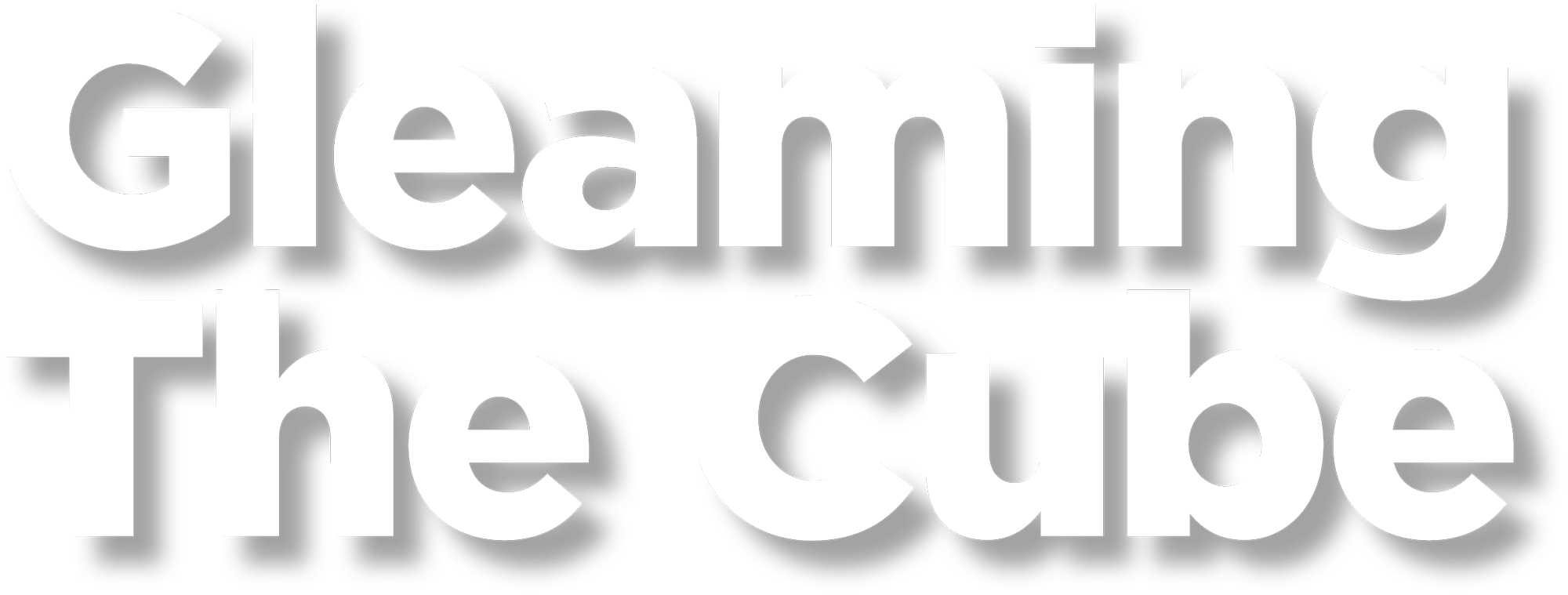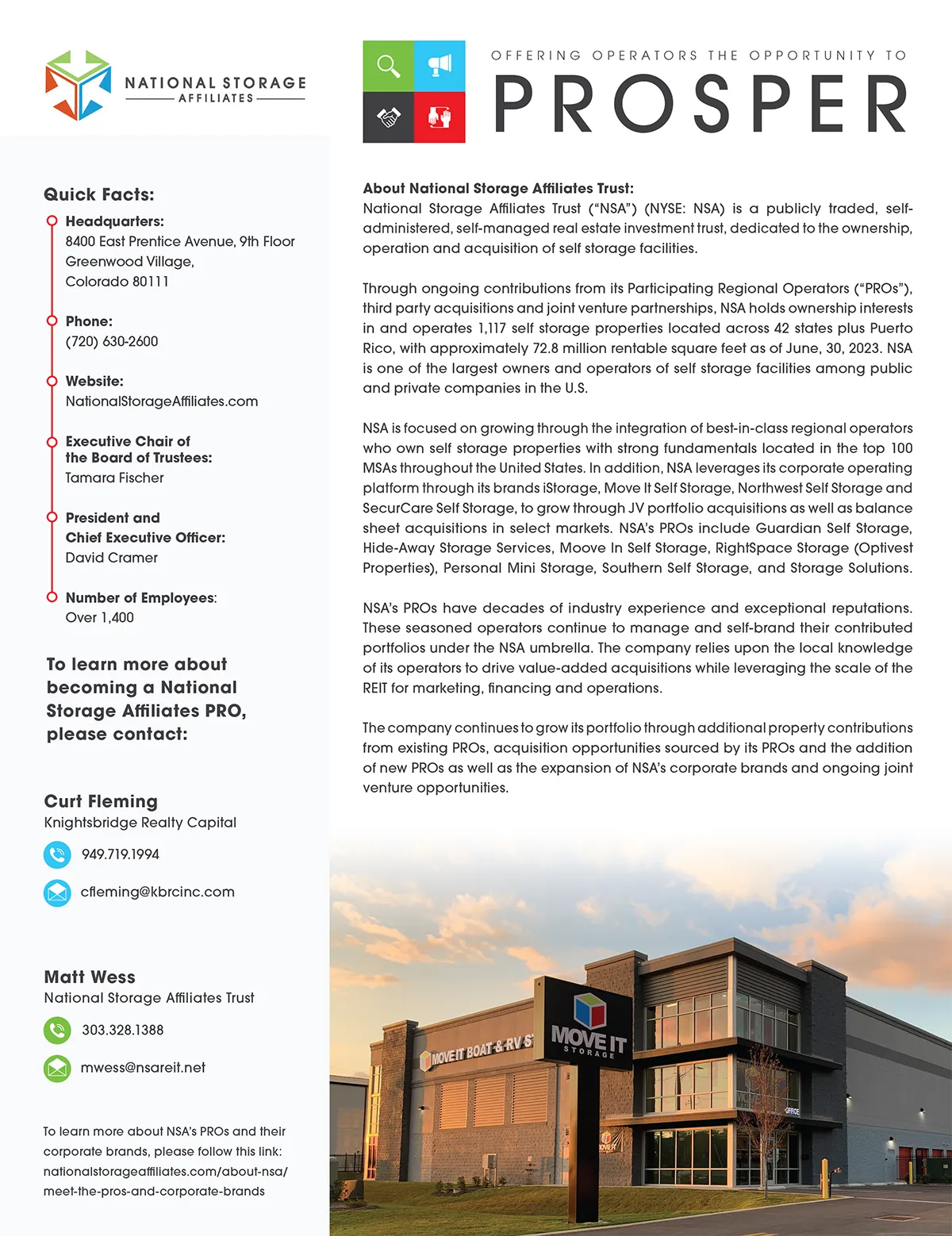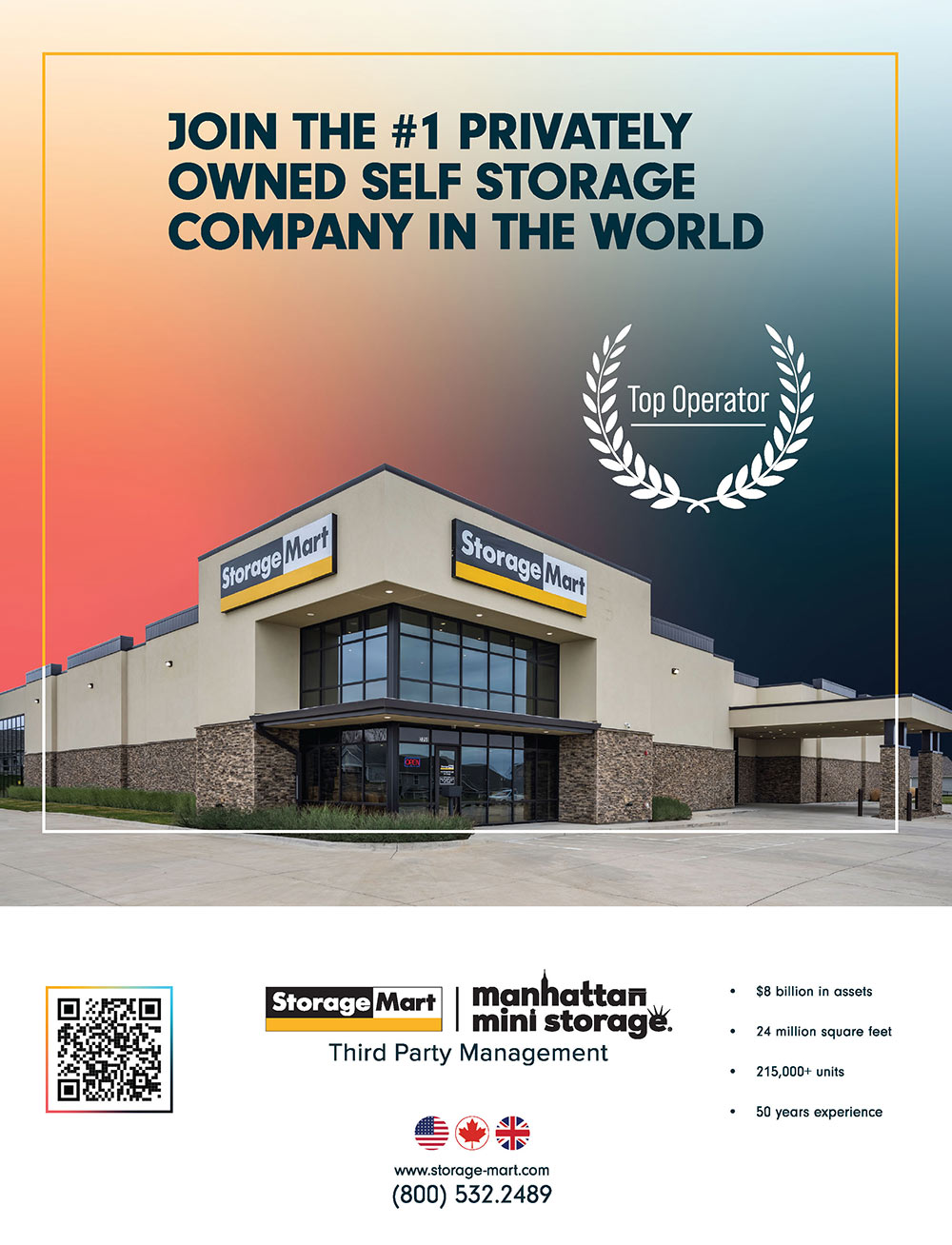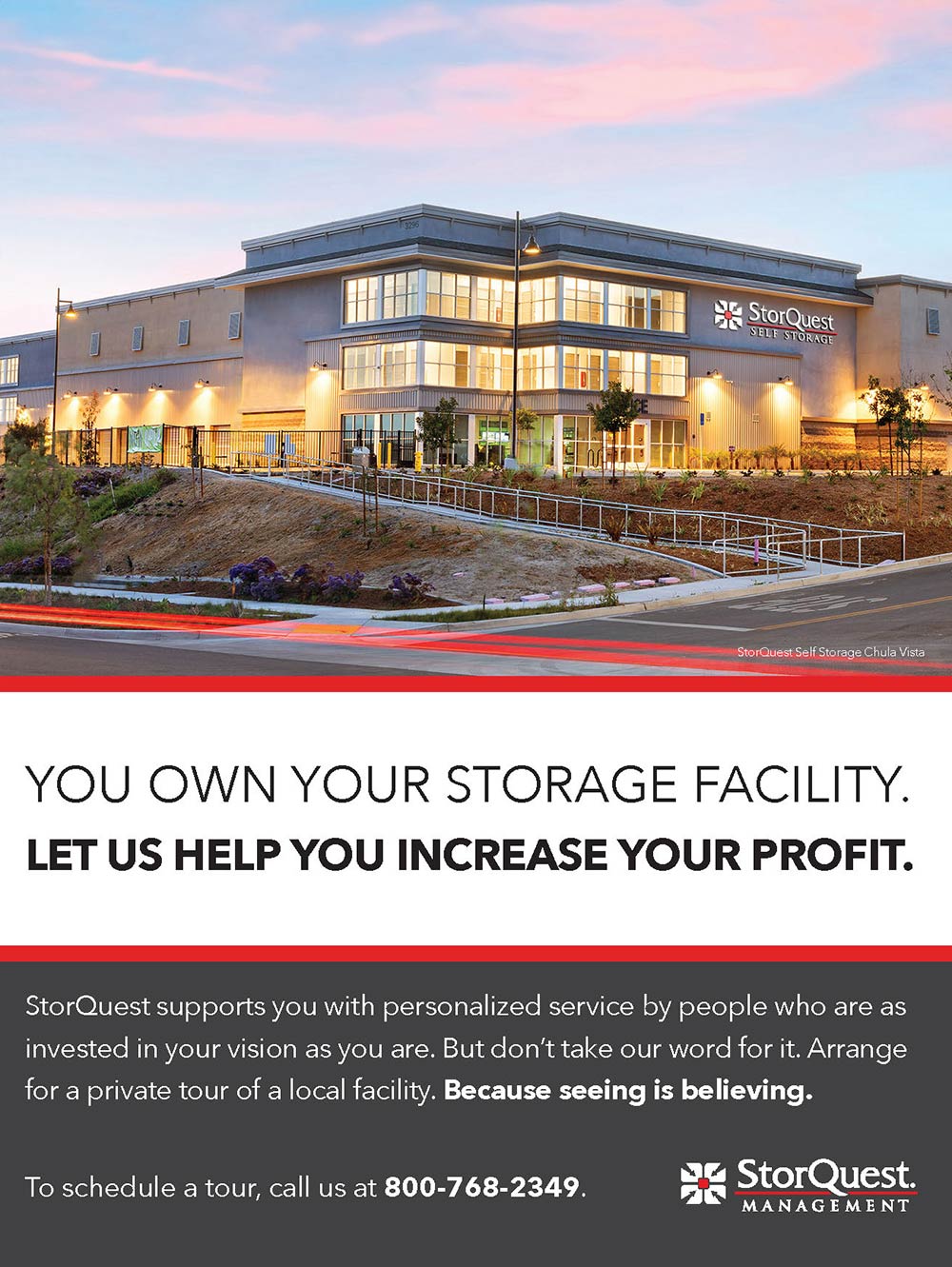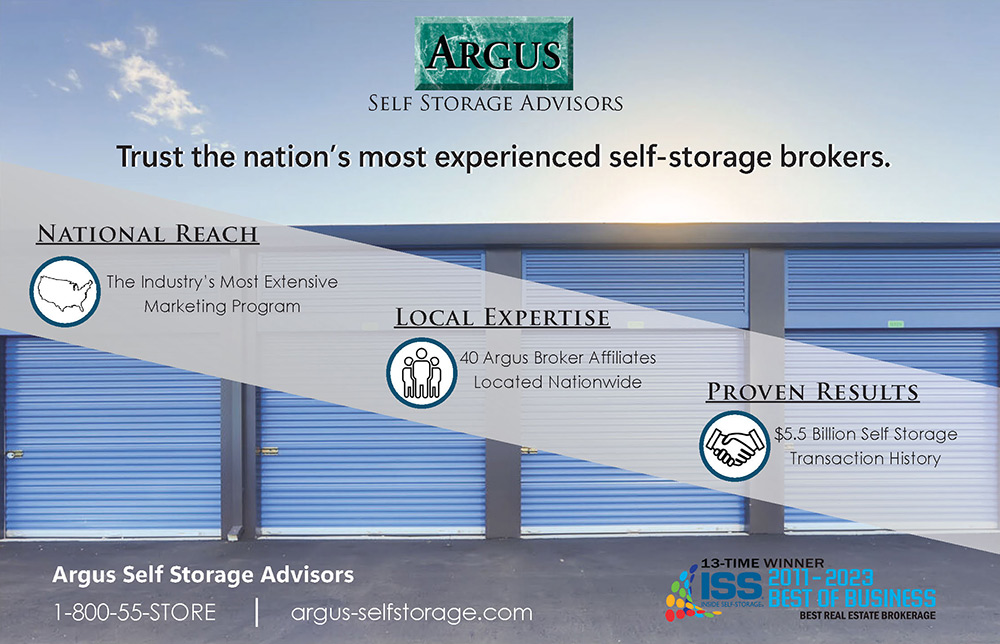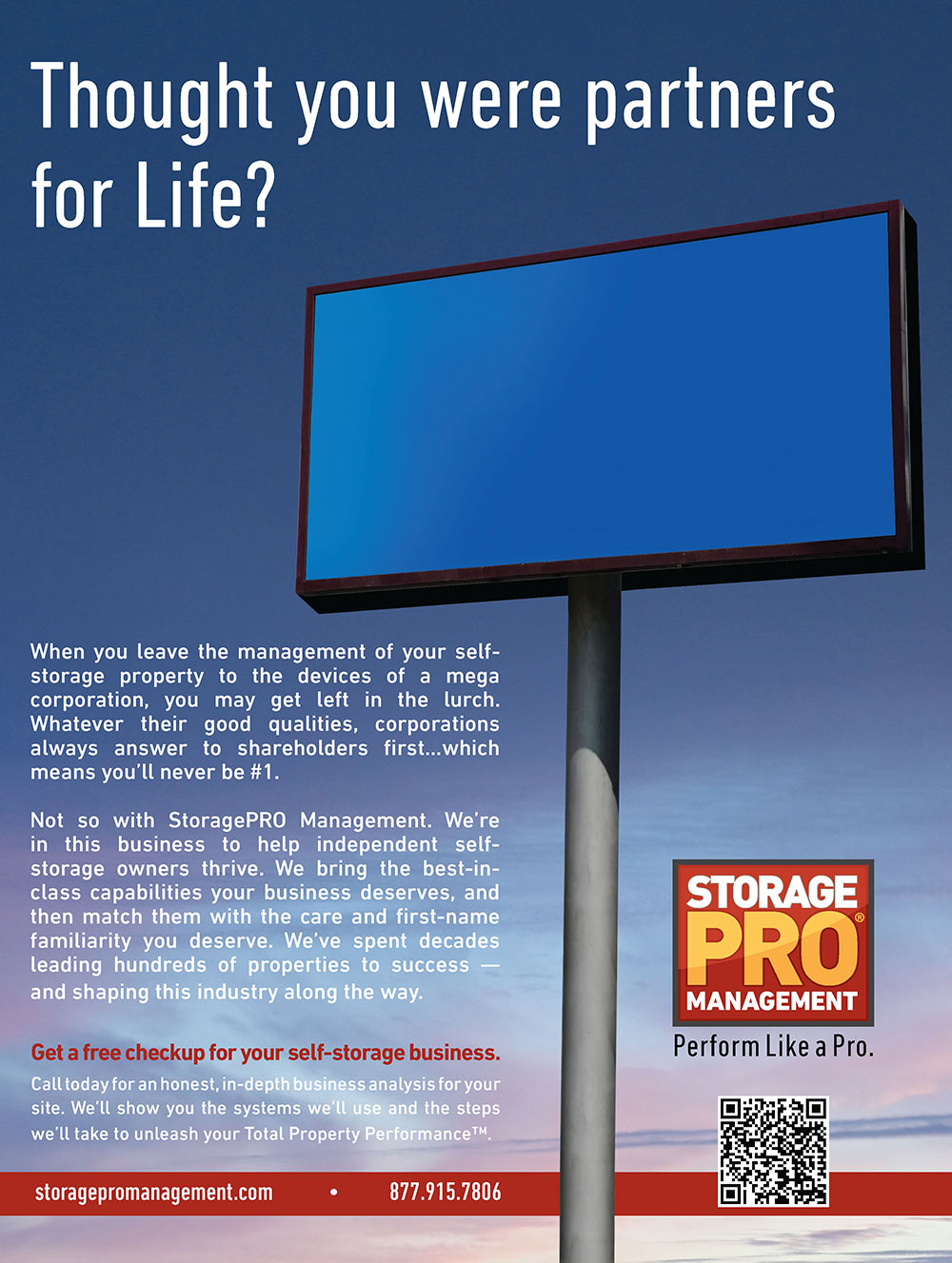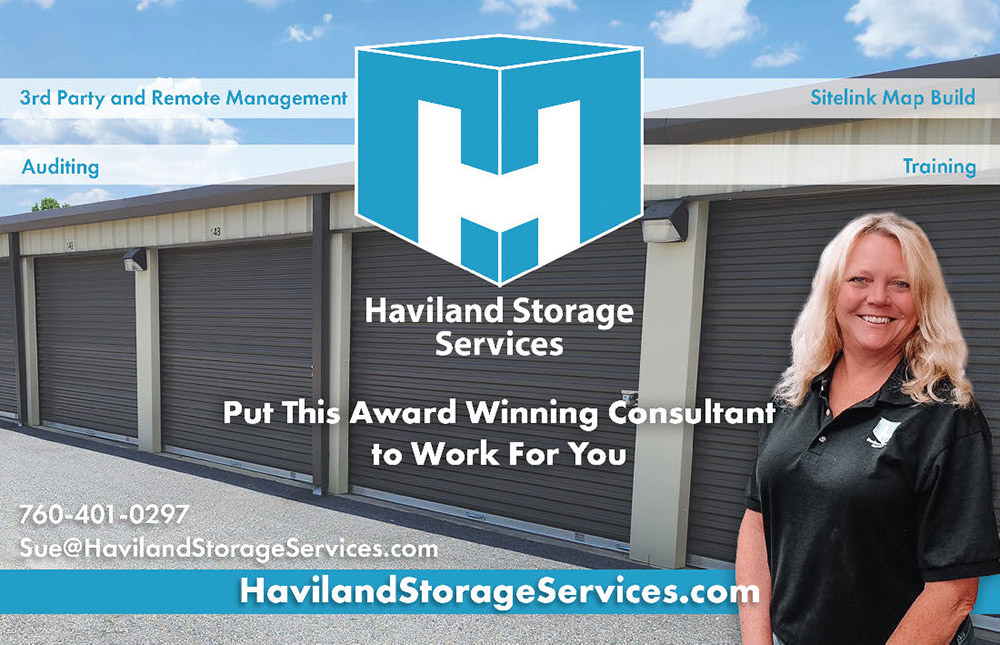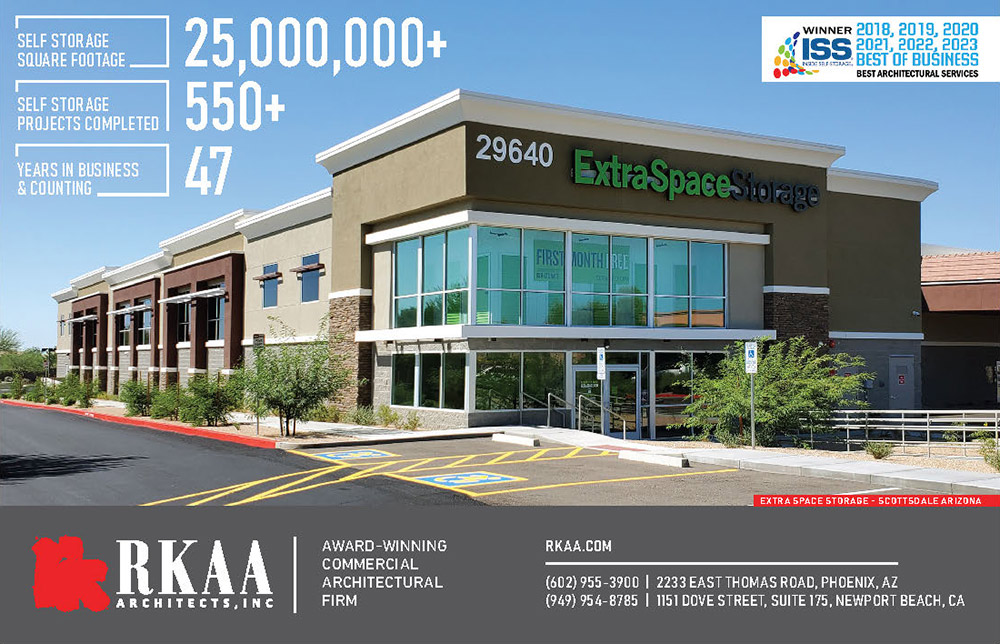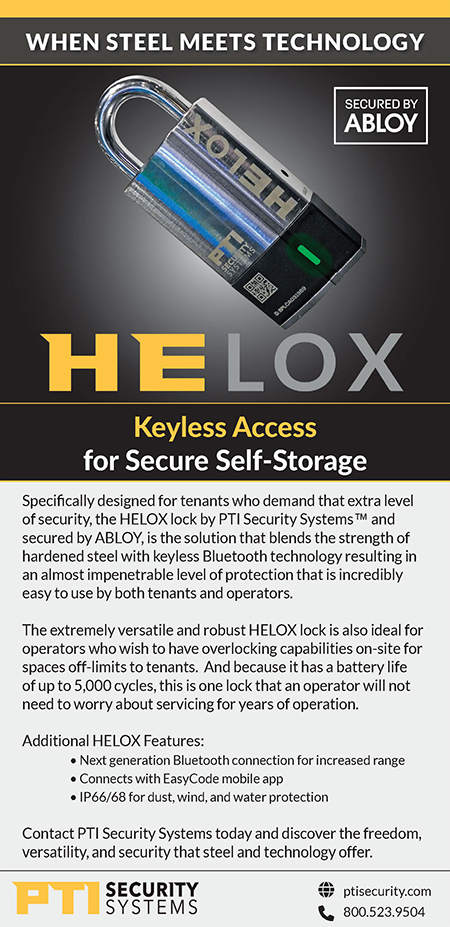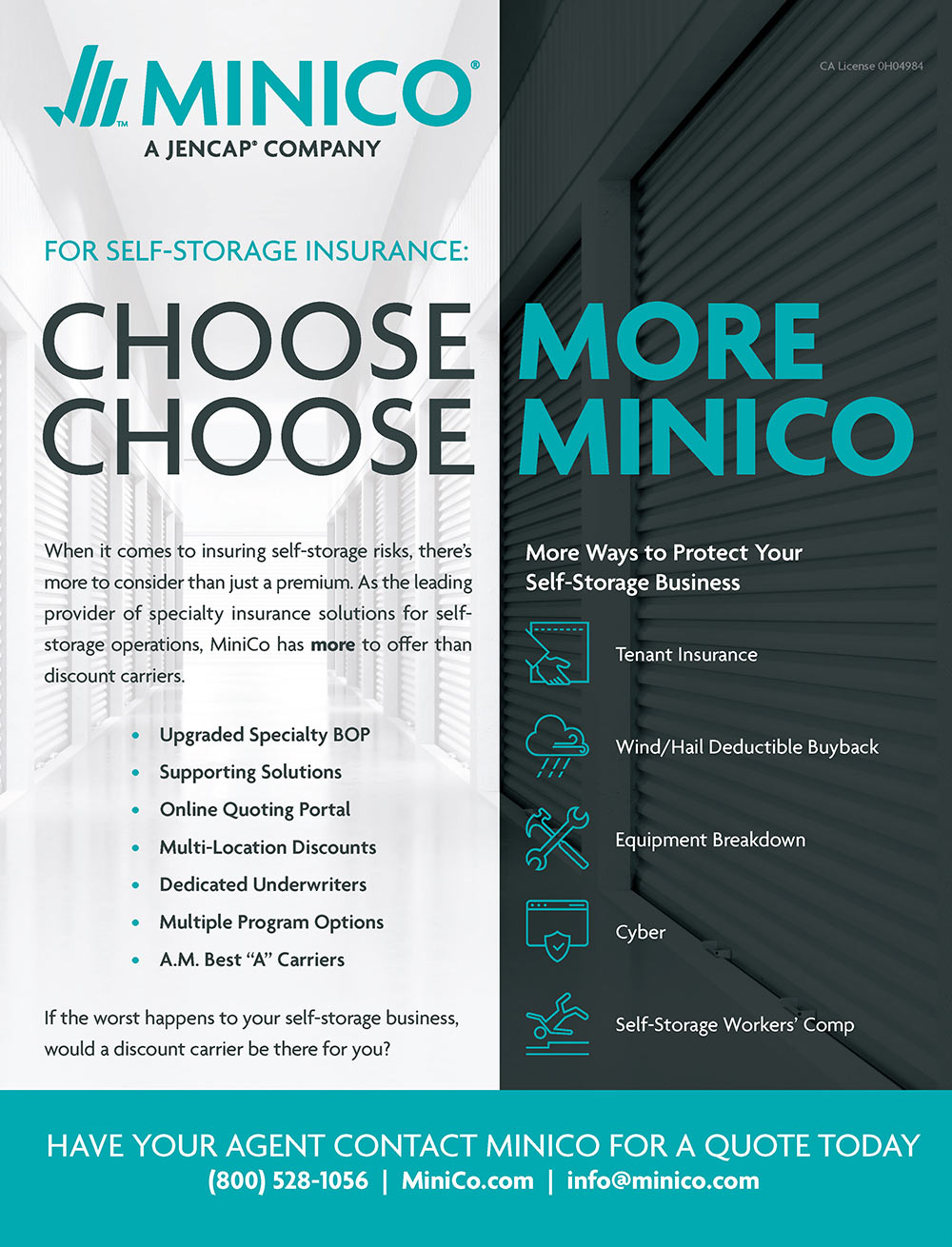How to enjoy our new magazine:
Just scroll!
Click or tap the table of contents icon in the menu bar to find any article.
Read any article by clicking or tapping the read full article button below each article intro.
Jump back to your previous browsing spot from any article using the menu bar or back to issue button.


-
The Commonalities Of Portable And Self-StoragePage 78
-
Finding The Right SitePage 80
-
Arizona Self Storage, Peoria, Ariz.Page 86
- Chief Executive Opinion by Travis Morrow 8
- Publisher’s Letter by Poppy Behrens 11
- Meet The Team 12
- AI Pulse by Jim Ross 21
- Women In Self-Storage: Elizabeth “Liz” Raun Schlesinger by Erica Shatzer 49
- Who’s Who In Self-Storage: Ryan Lorenzini by Erica Shatzer 53
- Charity Storage 95
- StorageGives 99
- Self Storage Association Update 102
- The Last Word: Arlen D. Nordhagen 104
For the latest industry news, visit our new website, ModernStorageMedia.com.

t’s not just the facility count, but it helps. Cutting-edge, albeit controversial, revenue management practices, adoption of smart technology. Extra Space is the new leader in our industry. #wwexrd?
He’s also the president of National Self Storage.

-
PUBLISHER
Poppy Behrens
-
Creative Director
Jim Nissen
-
Director Of Sales & Marketing
Lauri Longstrom-Henderson
(800) 824-6864 -
Circulation & Marketing Coordinator
Barbie Boyle
(800) 352-4636 -
Editor
Erica Shatzer
-
Web Manager / News Writer
Brad Hadfield
-
Storelocal® Media Corporation
Travis M. Morrow, CEO
-
MODERN STORAGE MEDIA
Jeffry Pettingill, Creative Director
-
Websites
-
Visit Messenger Online!
Visit our Self-Storage Resource Center online at
www.ModernStorageMedia.com
where you can research archived articles, sign up for a subscription, submit a change of address. 
- All correspondence and inquiries should be addressed to:
Modern Storage Media
PO Box 608
Wittmann, AZ 85361-9997
Phone: (800) 352-4636
elcome to the November 2023 edition of Messenger, our annual Top Operator’s issue. Starting on page 24, we are proud to present the top 100 operators in the self-storage industry based on net rentable square footage. While this year’s list includes many industry veterans, surprisingly, it also includes 26 operators that did not appear in 2022. Likewise, there are several that have dropped off due to consolidation or sales and acquisitions. A few days after becoming the new No. 2, Public Storage announced its own stellar acquisition: the $2.2 billion purchase of Blackstone Real Estate Income Trust, Inc.’s 127-property Simply Self Storage portfolio. And while CubeSmart and National Storage Associates (NSA) have kept their 2022 positions (third and fifth, respectively), U-Haul has rocketed up two.
As for the 26 operators in this edition that were not listed in 2022, some of those operators have been ranked on previous Top Operators lists, including Rosewood Property Company (No. 26) and East Penn Self Storage (No. 78); in 2021 they were ranked 30th and 80th, respectively. Two high-ranking newcomers on the list are KO Storage (No. 23) and NexPoint Storage Partners (No. 28). There are also a few new remote management companies this year, such as StoreEase Virtual Management (No. 63) and Remote Management Solutions (No. 67). Copper Storage Management, which has climbed 10 spots, from 42nd to 32nd, offers remote management services as well.
Last but not least, if you haven’t done so already, it is time to preorder the 2024 Self-Storage Almanac, which will be released in January. Featuring all new data by Radius+, the 2024 Almanac will also contain select customer information from the SSA’s newest Self Storage Demand Study. The Almanac will feature exclusive data about RV and boat storage as well. For more information about pre-ordering your Almanac, visit www.modernstoragemedia.com.
In closing, as we approach the holiday season, may our lives be full of both thanks and giving. And remember: There is always something for which to be thankful. Happy Thanksgiving!

Publisher

 Our annual Self-Storage Almanac, featuring new and exclusive data, is the industry’s most trusted resource!
Our annual Self-Storage Almanac, featuring new and exclusive data, is the industry’s most trusted resource! 
elcome to the November 2023 edition of Messenger, our annual Top Operator’s issue. Starting on page 24, we are proud to present the top 100 operators in the self-storage industry based on net rentable square footage. While this year’s list includes many industry veterans, surprisingly, it also includes 26 operators that did not appear in 2022. Likewise, there are several that have dropped off due to consolidation or sales and acquisitions. A few days after becoming the new No. 2, Public Storage announced its own stellar acquisition: the $2.2 billion purchase of Blackstone Real Estate Income Trust, Inc.’s 127-property Simply Self Storage portfolio. And while CubeSmart and National Storage Associates (NSA) have kept their 2022 positions (third and fifth, respectively), U-Haul has rocketed up two.
As for the 26 operators in this edition that were not listed in 2022, some of those operators have been ranked on previous Top Operators lists, including Rosewood Property Company (No. 26) and East Penn Self Storage (No. 78); in 2021 they were ranked 30th and 80th, respectively. Two high-ranking newcomers on the list are KO Storage (No. 23) and NexPoint Storage Partners (No. 28). There are also a few new remote management companies this year, such as StoreEase Virtual Management (No. 63) and Remote Management Solutions (No. 67). Copper Storage Management, which has climbed 10 spots, from 42nd to 32nd, offers remote management services as well.

 Our annual Self-Storage Almanac, featuring new and exclusive data, is the industry’s most trusted resource!
Our annual Self-Storage Almanac, featuring new and exclusive data, is the industry’s most trusted resource! 
In closing, as we approach the holiday season, may our lives be full of both thanks and giving. And remember: There is always something for which to be thankful. Happy Thanksgiving!

Publisher
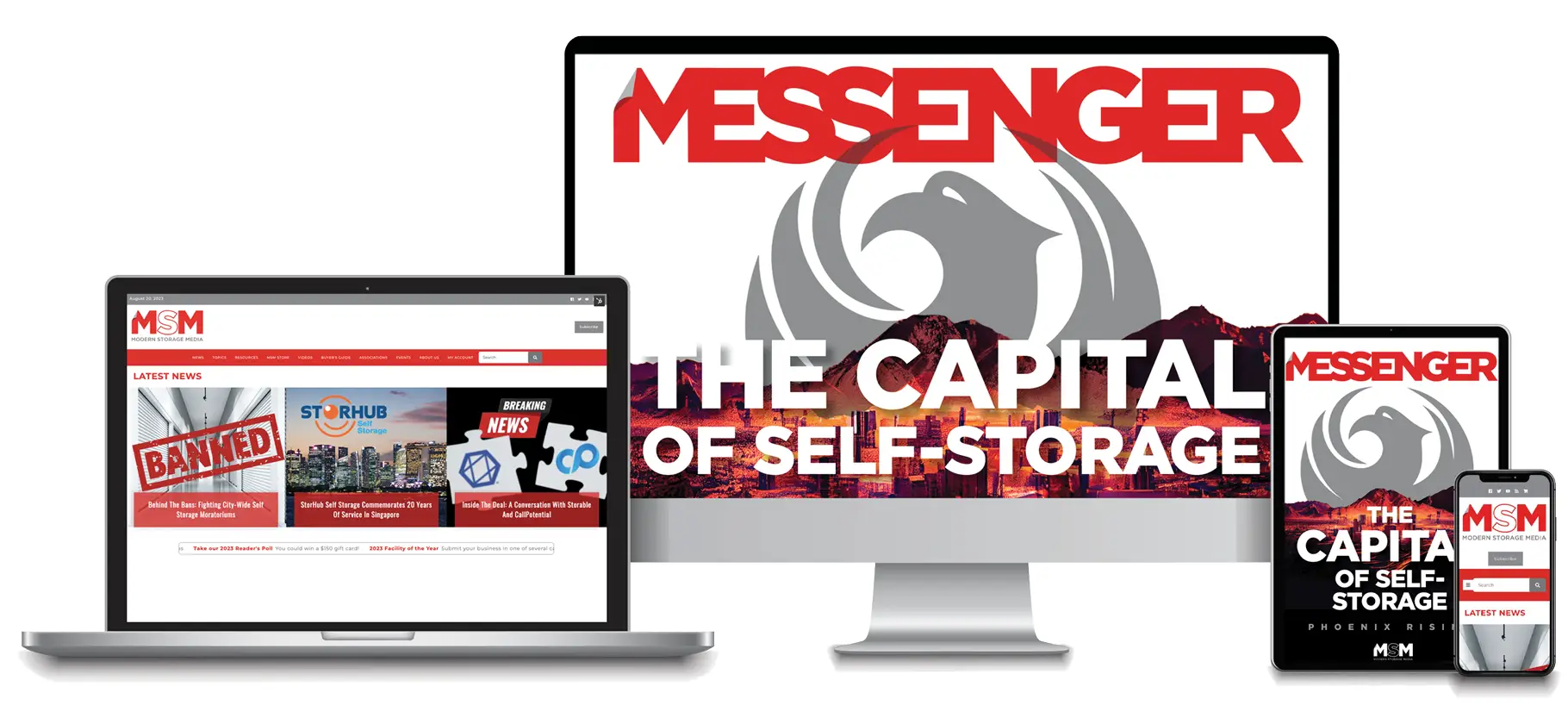
- Breaking news updated daily
- Real-time sales and acquisitions updates
- A newly redesigned calendar of events
- Enhanced promotional opportunities for advertisers
The website also enables readers to submit news, events, and article ideas. Don’t forget to browse the MSM Store for dozens of exclusive, storage-specific publications, including three of the industry’s most trusted resources: the annual Self-Storage Almanac, The RV & Boat Development Handbook, and the annual Expense Guidebook. New publications are frequently added to its extensive list of offerings!




Modern Storage Media



Messenger

any self-storage operators rent their units for 30 days, and while some may require a minimum stay, most offer month-to-month leases.
However, what happens when someone comes into your store and wants to rent a unit only for a week or even a day?
“We’ve had cases where we have given daily and weekly rentals,” says Carol Mixon, president of SkilCheck Services, Inc., in Tucson, Ariz. “I think it’s a good idea.”
While it isn’t a normal practice for many operators, Mixon says there are times it can be beneficial for the facility.
Mixon can recall several times she’s allowed a short-term rental, but the most interesting story happened when someone called wanting to store a whale overnight. Mixon thought it might be a prank at first, but this was no fish tale.
“Sea World in San Diego was transporting a whale from a facility on the East Coast to the West Coast,” explains Mixon. “The driver of the rig is mandated to stop every few hours to rest per federal guidelines, so the company called and asked if we would allow them to store the whale overnight in one of our units.”
Mixon says the company was out of options; the drivers couldn’t just park their precious cargo overnight in a hotel parking lot. “I had to call corporate and get the OK, and they finally said to go ahead and allow it,” says Mixon.
The driver backed up the rig into a 10-by-30. A guard was stationed outside of the unit while the driver got his mandatory sleep, and the whale and his transporter left the following morning.
If you have a facility in a college or military town, you may be able to fill in some vacancies by offering short-term rentals. “Sometimes military personnel and their families may be waiting for the government to move them and may only need the space for a week or two,” she says.
Students may also need to store their items short term while waiting for their dorms or apartments to be ready.
Mixon cites one case of a dentist who needed to store his office equipment in a unit for two weeks while he waited for his office to be remodeled. “The equipment went over the value limit for storage and no one else would rent to him,” says Mixon. “We finally received approval for him to store his equipment and he ended up paying more for two weeks than he would have paid for storing with us for a month.”
Mixon, who has managed properties in Hawaii, says some facilities there have even set up special hourly rates for tourists who need to check out of their hotel but have nowhere to store their luggage until their flight departs. “Those can be quite expensive and a good way for a facility near an airport to make additional income,” she says. “Some of those facilities charge up to $45 an hour to hold luggage.”
“In this contract, you must also add the agreement that if they go over the specified time they will have to pay the monthly amount,” says Mixon. “People often need storage for longer than they think, and it’s common for them to need it more than the day or week they thought they would.”
Mixon calculates a daily rate based on the monthly rate for the unit. “That may not be much, and we will then make a minimum rate for something as short as a day,” she adds.
Of course, if you charge administrative fees, those will still apply to set up the rental.
- Removing a unit from the market for a limited time when you could have secured a tenant on a month-to-month lease who would likely stay much longer.
- There is a lot of paperwork for less revenue. However, you could charge an extra administrative fee to help cover these costs.
- Managers must be trained on setting up these types of rentals in the management system.
Mixon says the advantage of allowing short-term rentals, especially if your competitors are not and will not do it, even in special circumstances, is the goodwill you establish with customers and the community. “That dentist who we rented to for a couple of weeks ended up coming back when he needed long-term storage and became a good, loyal customer,” says Mixon. “That really can’t be measured.”
y initial job in self-storage was a trainer for National Self Storage beginning in 1984. We created an amazing 10-day training course for managers in Tucson, Ariz. Once they successfully completed the course, the newly trained employees would return to their respective storage facilities located across six states. We observed that the employees were not retaining the training procedures, particularly selling over the phone and on site. So, we hired Donald Michalak, who wrote Making the Training Process Work, to evaluate our training program and speakers. He provided us with insight into our effectiveness as speakers and assessed our training materials.
I personally discovered his training book provided a practical, step-by-step guide to handle training challenges and the training process. Since I have a degree in both secondary education and vocal performance, his approach of training and maintaining behavior was a perfect fit. As a singer, or when trying to succeed at anything, you must constantly learn, train, and use your voice, racquet, club, etc. My parents started me in voice lessons at age 10, when my bible school teacher said that she thought I might have perfect pitch and an operatic voice. I could start every song in the correct key and stay in that same key. Young children and many adults can’t continually sing in the correct key. That is when I realized the importance of training and practice. I utilized both practice, performance, and feedback to improve my skills. Some people should not sing out loud; however, even if you don’t have a good voice, you will significantly improve if you have instruction and feedback. The same is true for selling goods. If you train an employee to sell in a particular manner, they tend to return to what is comfortable for them and not what is most effective. This is true for athletes, too. Your golf swing and follow-though can significantly enhance your game and results.
Michalak provided us with a great understanding of what was working well in our program and areas that needed improvement. We were able to train the employees effectively. However, we were not maintaining and following up on their training abilities, particularly on the employees’ phone and on-site sales. Michalak suggested that we evaluate the employees monthly to maintain the desired sales behavior.
Based on that principle, the idea of a one-time training course for sales skills is not sufficient. Michalak suggested that we evaluate each trained employee once a month and give them constructive, unbiased feedback. The employee does not know when the mystery call will be made, nor which recorded sales call will be evaluated. This keeps them on their toes for every sales call throughout the month. On occasion, my storage managers have told me that they got a low sales score because the office was busy, or they knew it was the shopper. Logically, my brain has trouble with both of those excuses for not doing a good job. They are implying that they offer poor sales or customer service when multitasking or when they know it’s a shopper. These are simply excuses for poor performance.
When the employee has a customer hanging out in the office just “shooting the bull,” they must prioritize what is happening in the office. If you have a current customer chatting with the manager in the office, the priority is the potential client on the phone.
Admittedly, this is only one sales call. However, each evaluation gives specific feedback in the following five objective areas (SkilCheck also utilizes 10 overall subjective sales skills):
- GREETING
- INQUIRY
- COUNSEL
- INVITATION
- CLOSING
- Effective sales presentation
- Controlling the sales call
- Built value in the store by selling the features and benefits
- Created a sense of urgency to visit/rent
- Handling qualifying questions
- Enthusiasm/friendliness/positive attitude
- Involved customer in the sales call
- Voice (rate of speech, clarity)
- Professionalism (rings, length of call, hold, attitude)
Our work force may be composed of the over 60 million members of Gen Z. They may appear much different than what we are used to seeing. Generally, they will be easily frustrated with outdated or dysfunctional software or any training that involves old technology. If we think about training younger employees, we need to create shorter instructional videos and put them on YouTube.
As I was writing this article, I zoomed with a client; we were discussing their mystery shops and he commented that one of his managers got a really low score. While talking with her about her low score, she shared the fact that she was just diagnosed with cancer. Job performance can be impacted by many factors. It is important to discuss low scores or even a change in the team member’s attitude, mood, habits, etc. You may discover something that is problematic for the employee that you would want to know about and help resolve.
Happy renting!

elcome to the inaugural edition of “AI Pulse: AI In Modern Storage,” a recurring column that delves deep into the transformative power of artificial intelligence (AI) in self-storage. In subsequent columns, we’ll dissect each topic further, focusing on cost-effectiveness, the elevation of customer service, and the tangible benefits AI brings in terms of profitability and efficiency for your self-storage business.
Self-storage businesses are no longer just about bricks, mortar, and space. They’re about smart spaces, digitally connected environments, and above all, enhanced customer experiences. The linchpin in this transformation is artificial intelligence (AI).
While envisioning the future possibilities of AI is exciting, recognizing and acting upon its present capabilities is crucial. It’s an invitation to innovate, a challenge to adapt, and most importantly, an opportunity to lead. The future of AI isn’t just on the horizon; it’s already here. The time to act, learn, and evolve is now.
Now, let’s delve into how I see AI will be revolutionizing customer service in the self-storage industry.
Furthermore, AI-powered voice bots can handle routine inquiries, freeing up human agents to tackle more complex issues. These bots are trained to understand nuances, accents, and even emotions in the caller’s voice, ensuring that the customer feels heard and understood. The results are reduced wait times, more efficient problem resolution, and a significantly enhanced customer experience.
- Customer Experience Revolution – AI isn’t merely a tool; it’s a catalyst for change. By enhancing customer interactions, AI ensures that every touchpoint, be it online or offline, is personalized and efficient. In a world where customer loyalty is gold, AI-driven personalization can be the differentiator that sets one business apart from its competitors.
- Operational Efficiency And Cost Savings – Beyond customer interaction, the ripple effect of AI’s optimization is felt in every corner of the business. From energy management in climate-controlled units to predictive maintenance, AI-driven decisions can lead to significant cost savings. These savings can be channeled back into the business, fueling further innovations and improvements.
- Future-Proofing The Business – In an ever-evolving technological landscape, early adoption of AI not only provides a competitive advantage but also prepares the business for future challenges. As AI technologies mature and become more accessible, businesses that have already integrated AI into their operations will be better positioned to harness its full potential.
- A Journey Of Discovery – The world of AI is vast and diverse. Each application, each algorithm, and each solution present an opportunity to learn and grow. By delving deep into AI’s intricacies, businesses can discover new avenues for growth, identify latent challenges, and craft strategies that are both innovative and effective.
With this series, our aim is to guide you through this journey of transformation and discovery. We’ll dive deep into each facet of AI’s influence on the self-storage industry, providing insights, analyses, and actionable takeaways. Join us in our upcoming editions as we explore the myriad ways in which AI can become the cornerstone of success for visionary, forward-thinking self-storage businesses.
hen self-storage professionals look back on 2023, they’ll likely recall one earth-shattering, industry-related event: It was the year Extra Space Storage and Life Storage joined forces to finally eclipse Public Storage as the largest self-storage real estate investment trust (REIT). The REITs announced their merger agreement just two months after Public Storage attempted to buy Life Storage through an acquisition strategy known as a bear hug.
The $12.7 billion, all-stock transaction was completed on July 20th, doubling Extra Space’s portfolio overnight and forming the “preeminent storage operator.” The combined REIT has an enterprise value of approximately $46 billion and a portfolio totaling more than 281 million net rentable square feet (NRSF) of storage. Life Storage, which is no longer listed individually, ranked fourth on the 2022 Top Operators list with 1,152 facilities and 89,667,400 NRSF.
Extra Space is now the No. 1 operator, but Public Storage isn’t too far behind at 249.7 million NRSF. A few days after becoming the new No. 2, Public Storage announced its own stellar acquisition: the $2.2 billion purchase of Blackstone Real Estate Income Trust, Inc.’s 127-property Simply Self Storage portfolio. That deal added 9 million NRSF to Public Storage’s portfolio near the end of July.
These consolidations, and others within the industry, have shaken up the rankings and enabled some operators to reach new heights. Though CubeSmart and National Storage Associates (NSA) have kept their 2022 positions (third and fifth, respectively), U-Haul has rocketed up two slots, from No. 6 to No. 4, by adding 136 facilities to its portfolio. Rounding out the top 10 is Storage Asset Management (No. 6), StorageMart (No. 7), Merit Hill Capital (No. 8), and Prime Group Holdings, which was ranked 11th in 2022 but pushed ahead of StorQuest (No. 10) to come in nineth this year.
As for the rest of the 2023 list, there are 26 operators in this edition that were not listed in 2022. Some of those operators have been ranked on previous Top Operators lists, including Rosewood Property Company (No. 26) and East Penn Self Storage (No. 78); in 2021 they were ranked 30th and 80th, respectively. Two high-ranking newcomers on the list are KO Storage (No. 23) and NexPoint Storage Partners (No. 28). There are also a couple new remote management companies this year, such as StoreEase Virtual Management (No. 63) and Remote Management Solutions (No. 67). Copper Storage Management, which has climbed 10 spots, from 42nd to 32nd, offers remote management services as well. Rising payroll costs, unexpected employment issues (truancy, turnover, and hiring difficulties), and the need to provide customers with contactless rentals are a handful of the reasons operators may be seeking alternatives to traditional on-site management.
Finally, for the fifth consecutive year, the 2023 list has a total of 101 operators. This is due to a tie between Nova Storage and Polo Properties for 90th place. Both operators reported a total of 900,000 net rentable square feet of storage space.
On the following pages, we present the 2023 Top Operators. As in the past, the list is compiled solely from information submitted in the annual Top Operators survey and the ranking is based on total net rentable square feet. Please note: Self-storage facilities that are owned and managed by the same company are only reported in the “Facilities Owned” section of the table.
We would like to extend our congratulations to all the top operators for their ability to grow their portfolios and expand the self-storage universe despite skyrocketing interest rates, flattening demand, and inflating expenses. May their adaptability and perseverance continue to inspire the future leaders of the self-storage industry.
- Extra Space Storage25
- Public Storage**25
- CubeSmart25
- U-Haul International**26
- National Storage Affiliates Trust26
- Storage Asset Management26
- StorageMart**26
- Merit Hill Capital26
- Prime Group Holdings, LLC26
- StorQuest Self Storage26
- Argus Professional Storage Management LLC26
- The Jenkins Organization, Inc.26
- SmartStop Self Storage REIT, Inc.**26
- Westport Properties, Inc.28
- Morningstar Properties28
- Reliant Real Estate Management28
- West Coast Self-Storage28
- Devon Self Storage28
- StoragePRO Management, Inc.28
- Store Space Self Storage28
- Mini Mall Storage**28
- Compass Self Storage28
- KO Storage28
- Brookwood Properties, LLC30
- Space Shop Self Storage30
- Rosewood Property Company30
- Metro Storage LLC30
- NexPoint Storage Partners30
- Universal Storage Group30
- TNT Self Storage Management30
- Self Storage Plus30
- Copper Storage Management30
- Safeguard Self Storage30
- Ramser Development Company30
- A-Affordable RV, Boat & Personal Storage32
- Pogoda Companies32
- Urban Self Storage32
- Baco Properties dba Security Public Storage32
- A-1 Self Storage32
- Purely Storage32
- Trojan Storage32
- Trusted Self Storage Professionals32
- Arcland Property Company32
- Metro Mini Storage32
- Right Move Storage, LLC34
- Dahn Corporation34
- Atomic Storage Group34
- Highline Storage Partners34
- 10 Federal Storage34
- Guardian Storage34
- Valley Storage34
- All Aboard Storage34
- Platinum Storage Group**34
- Cubix Asset Management34
- Prestige Capital Management34
- Cox’s Armored Mini Storage Management, Inc.36
- Attic Storage36
- RPM Storage Management LLC36
- All Purpose Storage LLC36
- SKS Management LLC36
- Superior Storage36
- Budget Store & Lock Self Storage36
- StoreEase Virtual Management36
- Value Store It Management, Inc.36
- Five Star Storage36
- StorageMax36
- Remote Management Solutions36
- Sentry Self Storage Management38
- Storage of America38
- Gulf Atlantic Asset Mgmt.38
- America West Management38
- 4217 Storage Management LLC38
- The Storage Mall Management Group38
- A-American Storage Management Co., Inc.38
- Ojai Oil Comapny / Golden State Storage38
- Synergy Storage Group38
- Donald Jones Consulting & Services38
- East Penn Self Storage38
- Han Capital40
- StorSafe40
- Century Storage40
- Haviland Storage Services40
- Wentworth Property Company40
- Artisan Properties, Inc.40
- Self-Storage Services, Inc.40
- National Business Management40
- Boardwalk Development Group40
- BPI Capital Management Inc.40
- United Properties Group40
- Polo Properties42
- Nova Storage42
- People Choice Storage42
- Guardian Self Storage42
- National Self Storage Management Inc.42
- Armor Storage42
- Incorporated Investments Inc.42
- Macho Self Storage42
- Self-Storage of Spokane42
- 180 Self-Storage42
- Serenity Storage42
- Amazing Spaces Storage Centers42
-
2795 E. Cottonwood Parkway, #300
Salt Lake City, UT 84121Phone: (877) 706-8139
Email: info@extraspace.com
Website(s): www.extraspace.com
Founded: 1977
Number of Facilities: 3,666
Total net rentable square footage: 281,122,977
Number of Facilities in Development: 25
Expansion plans: Extra Space Storage plans to grow aggressively over the next 12 months through third-party management, acquisitions, and developments. -
701 Western Avenue
Glendale, CA 91201Phone: (818) 244-8080
Website(s): www.publicstorage.com
President/CEO: Joe Russell
Email: gmiddlebrooks@cubesmart.com
Founded: 1972
Number of Facilities: 3,533
Total net rentable square footage: 249,700,000
Number of Facilities in Development: 30
Expansion plans: The REIT plans to continue expanding through property acquisitions, development, and redevelopment. -
5 Old Lancaster Road
Malvern, PA 19355Phone: (610) 535-5000
Email: gmiddlebrooks@cubesmart.com
Website(s): www.cubesmart.com
President/CEO: Chris Marr
Contact: Guy Middlebrooks
Founded: 2006
Number of Facilities: 1,338
Total net rentable square footage: 92,104,462
Number of Facilities in Development: 3
Expansion plans: The company will continue to evaluate expansion opportunities that meet its investment criteria. -
2727 N. Central Avenue
Phoenix, AZ 85004Phone: (602) 263-6811
Email: doconnor@uhaul.com
Website(s): www.UHaul.com
President/CEO: EJ Joe Shoen
Contact: Dennis O’Connor
Founded: 1945
Number of Facilities: 2,016
Total net rentable square footage: 86,055,568
Number of Facilities in Development: 175
Expansion plans: The company plans to expand its operation through acquisition of existing storage facilities, ground-up new construction projects, and conversions at existing facilities. -
8400 E. Prentice Avenue, 9th Floor
Greenwood Village, CO 80111Phone: (720) 630-2600
Email: mdowling@nsareit.net
Website(s): www.nationalstorageaffiliates.com
President/CEO: David Cramer
Contact: Matt Wess (mwess@nsareit.net)
Founded: 2013
Number of Facilities: 1,237
Total net rentable square footage: 81,802,520
Expansion plans: The company plans to grow through acquisitions and additional affiliates. -
3501 Concord Road, Suite 350
York, PA 17402Phone: (717) 779-1452
Email: info@storageasset.com
Website(s): www.storageassetmanagement.com
President/CEO: Alyssa Quill
Contact: Melissa Stiles
Founded: 2010
Number of Facilities: 597
Total net rentable square footage: 36,100,802
Number of Facilities in Development: 10
Expansion plans: The company plans to continue to balance growth with quality of management. -
215 N. Stadium Boulevard, Suite 207
Columbia, MO 65203Phone: (573) 449-0091
Email: sarah.little@storage-mart.com
Website(s): www.storage-mart.com
President/CEO: Cris Burnam
Contact: Alex Burnam
Founded: 1999
Number of Facilities: 289
Total net rentable square footage: 24,994,488
Number of Facilities in Development: 2
Expansion plans: Over the next 12 months, StorageMart envisions a strategic expansion plan focused on acquiring portfolios in its existing markets, identifying potential opportunities in secondary markets, and fostering growth in its third-party-managed portfolio. By leveraging its scalability and brand strength, StorageMart aims to provide owners with unparalleled support and maximize its presence in the self-storage industry. -
41 Flatbush, Suite 500A
Brooklyn, NY 11217Phone: (917) 398-5152
Email: ir@merithillcapital.com
Website(s): www.merithillcapital.com
President/CEO: Liz Raun Schlesinger
Contact: ir@merithillcapital.com
Founded: 2016
Number of Facilities: 350
Total net rentable square footage: 22,300,852
Expansion plans: Merit Hill continues to be an active buyer in the current market and has a robust acquisition pipeline. It will continue to execute its investment strategy across the U.S. over the next 12 months. -
85 Railroad Place
Saratoga Springs, NY 12866Phone: (518) 615-0552
Email: doug.kotelly@goprimegroup.com
Website(s): www.goprimegroup.com
President/CEO: Robert J. Moser
Contact: Doug Kotelly
Founded: 2013
Number of Facilities: 296
Total net rentable square footage: 22,128,062
Expansion plans: The company plans to continue actively acquiring and developing additional properties that complement its existing portfolio and align with its investment strategy. -
100 Wilshire Boulevard, Suite 400
Santa Monica, CA 90401Phone: (310) 451-2130
Email: bhobin@williamwarren.com
Website(s): www.storquest.com
President/CEO: William (Bill) Hobin
Contact: William (Bill) Hobin
Founded: 1994
Number of Facilities: 309
Total net rentable square footage: 19,400,309
Number of Facilities in Development: 5
Expansion plans: The company plans to expand the current operating platform through ground-up development, redevelopment, acquisitions, and third-party management in new and existing markets. -
2953 S. Peoria Street, Suite 200
Aurora, CO 80014Phone: (520) 320-9135
Email: info@argusstoragemanagement.com
Website(s): www.argusstoragemanagement.com
President/CEO: Ben Vestal/Korey Hanson
Contact: Korey Hanson
Founded: 2012
Number of Facilities: 247
Total net rentable square footage: 17,987,900
Expansion plans: The company plans to expand its third-party management services throughout the U.S., particularly in East Coast and Midwest markets. -
10600 Shadow Wood Drive, Suite 100
Houston, TX 77043Phone: (713) 622-6688
Email: rjenkins@jenkinsorg.com
Website(s): www.jenkinsorg.com
President/CEO: Ricky Jenkins
Contact: Ricky Jenkins
Founded: 1989
Number of Facilities: 49
Total net rentable square footage: 16,400,000
Number of Facilities in Development: 2
Expansion plans: The company plans to expand through value-add acquisitions. -
10 Terrace Road
Ladera Ranch, CA 92694Phone: (949) 429-6600
Email: ir@smartstop.com
Website(s): www.smartstop.com
President/CEO: H. Michael Schwartz
Contact: Wayne Johnson
Founded: 2005
Number of Facilities: 195
Total net rentable square footage: 15,494,000
Number of Facilities in Development: 15
Expansion plans: SmartStop plans to grow through targeted growth and stabilized assets in markets across the U.S. where it believes it can achieve economies of scale. In addition, SmartStop is targeting growth in the major Canadian markets, including expanding its footprint across the Greater Toronto Area. -
660 Newport Center Drive, Suite 1450
Newport Beach, CA 92660Phone: (949) 748-5900
Email: ramiroo@westportproperties.net
Website(s): www.westportproperties.net
President/CEO: Mike Brady
Contact: Ramiro Ochoa
Founded: 1985
Number of Facilities: 194
Total net rentable square footage: 13,920,497
Expansion plans: Westport plans to grow its existing footprint through strategic property development, property acquisition, and third-party management. -
725 Park Center Drive
Matthews, NC 28105Email: info@mstarproperties.com
Website(s): www.morningstarstorage.com
President/CEO: David Benson/Matthew Shapiro
Contact: info@mstarproperties.com
Founded: 1981
Number of Facilities: 107
Total net rentable square footage: 10,812,715
Number of Facilities in Development: 10
Expansion plans: The company has plans for continued expansion across the U.S. -
1146 Canton Street
Roswell, GA 30075Phone: (770) 609-8276
Email: tallen@reliant-mgmt.com
Website(s): www.reliant-mgmt.com
President/CEO: Todd Allen/Lew Pollack
Contact: jcordova@reliant-mgmt.com
Founded: 2009
Number of Facilities: 111
Total net rentable square footage: 9,593,700
Number of Facilities in Development: 7
Expansion plans: The company plans to expand through the acquisition of primarily value-add properties, be selective but opportunistic on development and conversion opportunities, and expand its footprint in Indiana and the Midwest. -
808 134th Street Southwest, Suite 211-B
Everett, WA 98204Phone: (206) 218-4959
Email: jeisenbarth@wcselfstorage.com
Website(s): www.WestCoastSelfStorage.com
President/CEO: Jim McNamee
Contact: John Eisenbarth
Founded: 2006
Number of Facilities: 115
Total net rentable square footage: 8,304,976
Number of Facilities in Development: 12
Expansion plans: The company plans to grow by 10 to 12 stores through third-party management, acquisition, and development. -
2000 Powell Street, Suite 1240
Emeryville, CA 94608Email: info@devonselfstorage.com
Website(s): www.devonselfstorage.com
President/CEO: Ken Nitzberg
Contact: Chuck Gamm
Founded: 1988
Number of Facilities: 118
Total net rentable square footage: 7,964,183
Number of Facilities in Development: 13
Expansion plans: The company plans to continue to pursue existing deals and development opportunities, including repurposing former retail or warehouse space. -
1615 Bonanza Street, Suite 208
Walnut Creek, CA 94596Phone: (925) 938-6300
Email: results@storagepro.com
Website(s): www.StorageProManagement.com
President/CEO: Stephen Mirabito
Contact: Jennifer Bielawski
Founded: 1974
Number of Facilities: 124
Total net rentable square footage: 7,860,127
Expansion plans: The company is now serving East Coast clients. -
330 E. Crown Point Road
Winter Garden, FL 34787Phone: (833) 786-7366
Email: info@storespace.com
Website(s): www.storespace.com
President/CEO: Chris Harris/Rob Consalvo
Contact: Chris Harris
Founded: 2018
Number of Facilities: 105
Total net rentable square footage: 7,742,632
Number of Facilities in Development: 19
Expansion plans: The company plans to purchase existing facilities nationwide, with a focus on value-add and conversion deals, along with selective development. It has 19 projects in development and 13 additional operating projects with an expansion component. -
1201 Glenmore Trail Southwest
Calgary, AB T2V 4Y8 CanadaPhone: (403) 984-9363
Email: info@minimallstorage.com
Website(s): www.minimallstorage.com
CEO: Adam Villard
Contact: Joshua Polkinghorne
Founded: 1976
Number of Facilities: 207
Total net rentable square footage: 7,725,211
Expansion plans: The company plans to expand by 40 percent of its current portfolio. -
20445 Emerald Parkway Drive, Suite 220
Cleveland, OH 44135Phone: (216) 458-0670
Email: shryszko@amdellcompanies.com
Website(s): www.compassselfstorage.com
President/CEO: Todd Amsdell
Contact: Steve Hryszko
Founded: 2007
Number of Facilities: 105
Total net rentable square footage: 7,690,617
Number of Facilities in Development: 7
Expansion plans: The company plans to continue to purchase existing and develop new self-storage facilities in markets where there is a need for self-storage. -
10301 Wayzata Boulevard
Minnetonka, MN 55305Phone: (952) 201-5382
Email: charles@kostorage.com
Website(s): www.kostorage.com
Principals: Jon Marshalla/Andrew Freeman
Contact: Charles@kostorage.com
Founded: 2016
Number of Facilities: 198
Total net rentable square footage: 7,076,297
Number of Facilities in Development: 5
Expansion plans: KO Storage plans to continue to acquire and develop properties that add scale to the current footprint of the company. In addition, it plans to continue with ground-up developments in targeted markets. -
10202 Jefferson Highway, B-2
Baton Rouge, LA 70809Phone: (225) 769-2950
Email: rpiper@thestoragecenter.com
Website(s): www.thestoragecenter.com
President/CEO: Craig Smith
Contact: Robby Piper
Founded: 1986
Number of Facilities: 69
Total net rentable square footage: 6,800,000
Number of Facilities in Development: 9
Expansion plans: The company plans to develop several ground-up facilities inside its existing footprint. -
5607 Glenridge Drive, Suite 200
Atlanta, GA 30342Phone: (678) 904-9609
Email: cliff@spaceshopselfstorage.com
Website(s): www.spaceshopselfstorage.com
President/CEO: Cliff Hite
Contact: cliff@spaceshopselfstorage.com
Founded: 2014
Number of Facilities: 83
Total net rentable square footage: 6,464,163
Number of Facilities in Development: 8
Expansion plans: The company plans to continue to grow through managing new sites in select markets. -
2101 Cedar Springs Road, Suite 1600
Dallas, TX 75201Phone: (214) 849-9041
Email: bcooke@rosewd.com
Website(s): www.rosewoodproperty.com
President/CEO: Rick Perdue
Contact: bcooke@rosewd.com
Founded: 1976
Number of Facilities: 79
Total net rentable square footage: 6,300,000
Number of Facilities in Development: 1
Expansion plans: The company plans to continue to grow its portfolio through strategic acquisitions, development, and expansions. -
13528 Boulton Boulevard
Lake Forest, IL 60045Phone: (847) 235-8900
Email: kbnagel@metrostorage.com
Website(s): www.metrostorage.com
President/CEO: Matthew M. Nagel/K. Blair Nagel
Contact: K. Blair Nagel
Founded: 1973
Number of Facilities: 89
Total net rentable square footage: 6,268,640
Number of Facilities in Development: 3
Expansion plans: The company plans to expand through the construction of ground-up and conversion facilities as well as acquisition of existing value-add and stabilized facilities. -
300 Crescent Court, Suite 700
Dallas, TX 75201Phone: (901) 612-1538
Email: aj@nexpoint.com
Website(s): www.nexpointstorage.com
President/CEO: CEO: John Good
Contact: Aaron Crowley
Founded: 2014
Number of Facilities: 69
Total net rentable square footage: 5,537,659
Expansion plans: The company expects to invest up to $100 million over the course of the next 12 months in either property acquisitions or new development. -
2700 Cumberland Parkway Southeast, Suite 530
Atlanta, GA 30339Phone: (770) 801-1888
Email: solutions@universalstoragegroup.com
Website(s): www.universalstoragegroup.com
President/CEO: Anthony J. Ross II
Contact: Sarah Beth Johnson
Founded: 1993
Number of Facilities: 78
Total net rentable square footage: 5,248,558
Number of Facilities in Development: 4
Expansion plans: USG plans to expand its footprint with both managed clients and new acquisitions. -
1260 N. Hancock
Anaheim, CA 92807Phone: (714) 777-2015
Email: dianne@tntmgmt.com
Website(s): www.totalstoragesolutions.com
President/CEO: Ray Tuohy
Contact: Ray Tuohy or Dianne Tanna
Founded: 1992
Number of Facilities: 75
Total net rentable square footage: 5,200,345
Number of Facilities in Development: 5
Expansion plans: The company will be adding more sites to its management portfolio. -
1055 Thomas Jefferson Street Northwest
Washington, DC 20007Phone: (855) 644-7587
Email: info@selfstorageplus.com
Website(s): www.selfstorageplus.com
President/CEO: Noah Mehrkam
Contact: Jennifer Martinez
Founded: 1988
Number of Facilities: 67
Total net rentable square footage: 5,200,000
Number of Facilities in Development: 10
Expansion plans: The company plans to increase its store count to 80 total stores. -
174 Island Breeze Way
Daytona Beach, FL 32174Phone: (571) 277-9299
Email: terry@coppersm.com
Website(s): www.copperstoragemanagement.com
CEO: Terry Campbell
Contact: Tess Toth
Founded: 2019
Number of Facilities: 174
Total net rentable square footage: 5,189,227
Expansion plans: The company plans to manage 25 new facilities over the next 12 months. -
3384 Peachtree Road, 4th Floor
Atlanta, GA 30326Phone: (404) 231-4000
Email: info@safeguardit.com
Website(s): www.safeguardit.com
President/CEO: Mark Degner
Contact: Kurt Kleindienst
Founded: 1989
Number of Facilities: 87
Total net rentable square footage: 5,100,615
Number of Facilities in Development: 15
Expansion plans: The company has 15 properties in various stages of development and intends to add five to 10 facilities per year for the foreseeable future. -
901 Dove Street
Newport Beach, CA 92660Phone: (949) 307-9313
Email: scott@ramserdevco.com
Website(s): www.ramserdevco.com
President/CEO: Scott Ramser
Contact: Claire Curci
Founded: 1986
Number of Facilities: 21
Total net rentable square footage: 5,015,726
Number of Facilities in Development: 1
Expansion plans: The company plans to purchase six facilities with $72 million in value. -
725 Highway 287 North
Mansfield, TX 76063Phone: (817) 874-0183
Email: manager@a-affordablestorage.net
Website(s): www.a-affordablestoage.net
President/CEO: Mitch Breedn
Contact: John Hall
Founded: 2017
Number of Facilities: 28
Total net rentable square footage: 4,469,481
Number of Facilities in Development: 8
Expansion plans: The company hopes to add at five or six more facilities to the eight it has in development. -
32300 Northwestern Highway, Suite 110
Farmington Hills, MI 48334Phone: (248) 855-9676
Email: info@pogodaco.com
Website(s): www.pogodaco.com
President/CEO: Adam Pogoda
Contact: Adam Pogoda
Founded: 1987
Number of Facilities: 68
Total net rentable square footage: 4,350,000
Number of Facilities in Development: 4
Expansion plans: The company plans to buy three to five new facilities, add five to seven management accounts, and build/convert three to four properties. -
918 S. Horton Street, Suite 1000
Seattle, WA 98134Phone: (206) 859-6550
Email: info@urbanstorage.com
Website(s): www.urbanstorage.com
President/CEO: Julia Reed-Voldal
Contact: Patrick Reilly
Founded: 1986
Number of Facilities: 78
Total net rentable square footage: 4,348,725
Number of Facilities in Development: 23
Expansion plans: The company plans to add another 12,000 units and 1.3 million square feet to its portfolio. -
128 King Street, Suite 400
San Francisco, CA 94107Phone: (415) 281-3700
Email: meisler@bacoproperties.com
Website(s): www.bacoproperties.com; www.securitypublicstorage.com
President/CEO: Ben Eisler
Contact: Michael Eisler
Founded: 1983
Number of Facilities: 52
Total net rentable square footage: 4,200,000
Number of Facilities in Development: 2
Expansion plans: The company plans to continue to expand via ground-up development, conversion of existing buildings, and acquisition of operating properties to Security Public Storage premium-brand self-storage facilities. -
4607 Mission Gorge Place
San Diego, CA 92120Phone: (619) 287-8873
Email: brcaster@castergrp.com
Website(s): www.a1storage.com
CEO: Brian R. Caster
Founded: 1959
Number of Facilities: 48
Total net rentable square footage: 4,040,078
Number of Facilities in Development: 2
Expansion plans: The company plans to open two new locations. -
20371 Irvine Avenue, Suite 100
Newport Beach, CA 92660Phone: (949) 281-6017
Email: parker@purelystorage.com
Website(s): www.purelystorage.com
President/CEO: Brad Lund
Contact: Parker Lund
Founded: 2009
Number of Facilities: 50
Total net rentable square footage: 3,879,891
Expansion plans: The company plans to purchase three facilities in the next 12 months. -
1732 Aviation Boulevard, Suite 217
Redondo Beach, CA 90278Phone: (310) 372-8600
Email: info@trojanstorage.com
Website(s): www.trojanstorage.com
President/CEO: Brett Henry/John Koudsi
Contact: Aimee Romero
Founded: 2007
Number of Facilities: 43
Total net rentable square footage: 3,849,400
Number of Facilities in Development: 11
Expansion plans: The company has plans for the development of another one million square feet. -
6200 Grissom Road
San Antonio, TX 78238Phone: (210) 355-7074
Email: vianney@pmitx.com
Website(s): www.trustedselfstorageprofessionals.com
President/CEO: Vianney Jasik
Contact: vianney@pmitx.com
Founded: 2013
Number of Facilities: 45
Total net rentable square footage: 3,804,313
Number of Facilities in Development: 2
Expansion plans: The company is always open for expansion. -
1055 Thomas Jefferson Street Northwest
Washington, DC 20007Phone: (202) 243-7523
Email: anthony@arc.land
Website(s): www.arc.land
President/CEO: Noah Mehrkam
Contact: Anthony Piscitelli
Founded: 2006
Number of Facilities: 44
Total net rentable square footage: 3,741,000
Number of Facilities in Development: 15
Expansion plans: The company is pursuing new development sites and existing store acquisitions on the East Coast and throughout the Southeast. -
100 Metro Parkway
Pelham, AL 35124Phone: (205) 443-3522
Email: shane@metrocompanies.com
Website(s): www.metroministorage.com
President/CEO: Eddie Lumpkin
Contact: Shane Sisk
Founded: 1978
Number of Facilities: 26
Total net rentable square footage: 3,650,000
Number of Facilities in Development: 2
Expansion plans: The company plans to build a new facility and expand three facilities. -
2550 Gray Falls Drive, Suite 400
Houston, TX 77077Phone: (713) 789-2200
Email: dkelley@rightmovestorage.com
Website(s): www.rightmovestorage.com
President/CEO: Darren Kelley
Contact: Darren Kelley
Founded: 2013
Number of Facilities: 63
Total net rentable square footage: 3,621,326
Number of Facilities in Development: 3
Expansion plans: The company plans to continue to embrace cutting-edge technology that provides a competitive advantage of exclusivity in the markets in which it operates while expanding its brand of managed properties. -
4675 MacArthur Court, Suite 1400
Newport Beach, CA 92660Phone: (949) 752-1282
Email: rbradley@dahncorp.com
Website(s): www.miniustorage.com
President/CEO: Brian A. Dahn
Contact: Robert Bradley, Jr.
Founded: 1972
Number of Facilities: 49
Total net rentable square footage: 3,463,177
Expansion plans: The company plans to build or acquire three to five facilities per year. -
5958 Snow Hill Road, 144 137
Ooltewah, TN 37363Phone: (337) 380-4029
Email: magen@atomicstoragegroup.com
Website(s): www.atomicstoragegroup.com
President/CEO: Magen Smith/Rick Beal
Contact: info@atomicstoragegroup.com
Founded: 2019
Number of Facilities: 66
Total net rentable square footage: 3,287,000
Number of Facilities in Development: 1 -
2033 Monroe Drive
Atlanta, GA 30324Phone: (404) 643-8245
Email: jberry@highlinesp.com
Website(s): www.highlinesp.com
President/CEO: Jim Berry/Key Foster
Contact: Jim Berry
Founded: 2019
Number of Facilities: 52
Total net rentable square footage: 3,238,228
Number of Facilities in Development: 6
Expansion plans: The company plans to grow through acquisitions, development, and expansions throughout Sunbelt and mountain state markets. -
3301 Atlantic Avenue
Raleigh, NC 27604Phone: (919) 307-4383
Email: acapranos@10federal.com
Website(s): www.10federalstorage.com
Owners: Brad & Cliff Minsley
President: Andrew Capranos
Contact: Andrew Capranos
Founded: 2010
Number of Facilities: 74
Total net rentable square footage: 3,222,330
Expansion plans: The company is currently raising its fourth self-storage fund; it’s adding roughly 20 to 30 properties to its portfolio per year. -
5879 Centre Avenue
Pittsburgh, PA 15206Phone: (412) 626-6007
Email: coz@guardianstorage.com
Website(s): www.GuardianStorage.com
President/CEO: Steven Cohen
Founded: 1987
Number of Facilities: 37
Total net rentable square footage: 3,130,103
Number of Facilities in Development: 2
Expansion plans: Guardian Storage will continue to grow through development of new locations and revenue management tools. -
1825 Howell Road, Suite 4
Hagerstown, MD 21740Phone: (301) 667-2873
Email: todd@valleystorage.com
Website(s): www.valleystorage.com
President/CEO: Todd Snook
Contact: Todd Snook
Founded: 1986
Number of Facilities: 58
Total net rentable square footage: 3,036,527
Expansion plans: The company plans to purchase five to 10 locations in its existing footprint. -
5111 S. Ridgewood Avenue, Suite 201
Port Orange, FL 32127Phone: (386) 236-1970
Email: aclark@goallaboard.com
Website(s): www.Allaboardstorage.com
President/CEO: D. Andrew Clark
Contact: D. Andrew Clark
Founded: 1983
Number of Facilities: 31
Total net rentable square footage: 3,022,357
Number of Facilities in Development: 2
Expansion plans: The company plans to continue buying, expanding, and building more locations. -
4920 Campus Drive, Suite A
Newport Beach, CA 92660Phone: (949) 381-3831
Email: Info@platinumstorage.com
Website(s): www.Platinumstorage.com
President/CEO: Daniel “Skip” Elefante
Contact: Customerservice@platinumstorage.com
Founded: 1999
Number of Facilities: 41
Total net rentable square footage: 2,828,291
Number of Facilities in Development: 4
Expansion plans: The company will continue to grow its management platform throughout the U.S. as well as buy when appropriate in growing markets with strong demographics. -
PO Box 699
Danville, CA 94526Phone: (925) 743-0869
Email: info@cubixstorage.com
Website(s): www.cubixstorage.com
President/CEO: George Huff, Sean Venezia, Ed Boersma
Contact: sean@cubixstorage.com
Founded: 2018
Number of Facilities: 38
Total net rentable square footage: 2,800,000
Expansion plans: The company is always seeking new development, acquisitions, and property management. -
383 N. Front Street
Columbus, OH 43215Phone: (614) 362-8958
Email: cory@prestigestoreit.com
Website(s): www.prestigestoreit.com
President/CEO: Cory Bonda
Contact: cory@prestigestoreit.com
Founded: 2016
Number of Facilities: 57
Total net rentable square footage: 2,797,588
Number of Facilities in Development: 3
Expansion plans: The company is actively seeking acquisition and development opportunities in new and existing markets, with a goal of adding 10 to 12 properties per year. -
1650 E. Lamar Road
Phoenix, AZ 85016Phone: (602) 997-9690
Email: storagelady@aol.com
Website(s): www.armored-mini-storage.com
President/CEO: Diane M. Gibson
Contact: Diane M. Gibson
Founded: 1995
Number of Facilities: 20
Total net rentable square footage: 2,511,492
Number of Facilities in Development: 1
Expansion plans: The company plans to add two new sites to add to its portfolio. -
401 S. Washington Street
Fredericksburg, TX 78624Email: tsmoose2000@yahoo.com
Website(s): www.atticstorages.com
President/CEO: Sharon Moose
Contact: Sharon Moose
Founded: 2005
Number of Facilities: 4
Total net rentable square footage: 2,500,000 -
1659 SH 46 West, Suite 115-434
New Braunfels, TX 78132Phone: (830) 832-9496
Email: rpmstoragemanagement@outlook.com
Website(s): www.rpmstoragemanagement.com
President/CEO: Monty Rainey
Contact: Monty Rainey
Founded: 2014
Number of Facilities: 42
Total net rentable square footage: 2,444,700
Number of Facilities in Development: 2
Expansion plans: The company has eight Texas developments in the pipeline. -
4007 Dean Martin Drive
Las Vegas, NV 89103Phone: (702) 550-3808
Email: admin@patriotholdings.com
Website(s): www.patriotholdings.com
President/CEO: Jeremiah Boucher
Contact: admin@patriotholdings.com
Founded: 2007
Number of Facilities: 84
Total net rentable square footage: 2,328,464
Number of Facilities in Development: 9
Expansion plans: The company plans to purchase 25 facilities. -
1939 Harrison Street, Suite 410
Oakland, CA 94612Phone: (510) 273-8887
Email: nochi@sksmgmt.com
Website(s): www.sksmgmt.com
President/CEO: Natolie Ochi
Contact: Natolie Ochi
Founded: 1998
Number of Facilities: 26
Total net rentable square footage: 2,209,905
Number of Facilities in Development: 1
Expansion plans: The company plans to add one or two third-party management contracts to its portfolio. -
74 Halbach Court
Fond du Lac, WI 54937Phone: (920) 267-6210
Email: sjuiris@gmail.com
Website(s): https://www.SuperiorStorage.com
President/CEO: Steve Juiris
Contact: Steve Juiris
Founded: 2014
Number of Facilities: 31
Total net rentable square footage: 2,183,400
Expansion plans: The company plans to expand through strategic acquisitions that complement its existing portfolio. -
1090 MacArthur Road
Whitehall, PA 18052Phone: (610) 435-3300
Email: Budgetstorageus@yahoo.com
Website(s): https://www.Budgetstorageandlock.com
President/CEO: Michael Moyer/Joe Mooney
Contact: Dean Moyer or Ricky Moyer
Founded: 1997
Number of Facilities: 46
Total net rentable square footage: 2,177,000
Number of Facilities in Development: 3
Expansion plans: The company plans to build or acquire three to four facilities a year. -
3800 Colonnade Parkway
Birmingham, AL 35243Phone: (205) 964-9660
Email: matt@storeease.com
Website(s): https://www.storeease.com
President/CEO: Josh Boyd
Founded: 2019
Number of Facilities: 40
Total net rentable square footage: 2,076,492
Expansion plans: The company is projected to be at a total of 85 properties over the next 12 months. -
3201 W. Commercial Boulevard, #218
Fort Lauderdale, FL 33309Phone: (305) 758-8898
Email: cdiaz@valuestoreit.com
Website(s): https://www.valuestoreit.com
President/CEO: Todd Ruderman
Contact: Bryan Lekas
Founded: 2003
Number of Facilities: 32
Total net rentable square footage: 1,985,732
Number of Facilities in Development: 2
Expansion plans: The company plans to add two facilities to its portfolio. -
3255 43rd Street South
Fargo, ND 58104Phone: (701) 293-1701
Email: ben@fivestarstorage.biz
Website(s): https://www.fivestarstorage.biz
President/CEO: Ben Hendricks
Contact: Chris Kampmeyer (chrisk@fivestarstorage.biz)
Founded: 2004
Number of Facilities: 34
Total net rentable square footage: 1,944,700
Number of Facilities in Development: 1
Expansion plans: The company will be adding over 100,000 rentable square feet at various existing locations with vacant land and repurposing land. It will continue to seek new deals for acquisitions and new development opportunities. -
599B Steed Road
Ridgeland, MS 39157Phone: (601) 573-2504
Email: info@stomax.com
Website(s): https://www.stomax.com
President/CEO: Robert L. Lloyd
Contact: Nick Newcomb
Founded: 1993
Number of Facilities: 33
Total net rentable square footage: 1,937,150
Number of Facilities in Development: 3
Expansion plans: The company plans to continue to expand across the Southeast through acquisitions and development. -
PO Box 701320
West Valley, UT 84170Phone: (801) 381-3298
Email: jim@rmstoragesolutions.com
Website(s): https://www.remotemanagementsolutions.com
President/CEO: Jim Ross, Cindy Ashby, Matt VanHorn
Contact: jim@rmstoragesolutions.com
Founded: 2023
Number of Facilities: 36
Total net rentable square footage: 1,847,020 -
12375 W. Sample Road
Coral Springs, FL 33065Phone: (954) 228-4611
Email: nschulman@sentry-selfstorage.com
Website(s): https://www.sentry-selfstorage.com
President/CEO: Norman Schulman
Contact: Scott McLaughlin (smclaughlin@sentry-selfstorage.com)
Founded: 1998
Number of Facilities: 24
Total net rentable square footage: 1,820,652
Number of Facilities in Development: 3
Expansion plans: The company is focusing on site selections for further potential development. -
4225 W. 62nd Street
Indianapolis, IN 46268Phone: (801) 652-3134
Email: dwalker@storageofamerica.com
Website(s): https://www.storageofamerica.com
President/CEO: Robert Walker
Contact: Derek Walker
Founded: 2003
Number of Facilities: 28
Total net rentable square footage: 1,783,670
Number of Facilities in Development: 25
Expansion plans: The company plans to continue developing new sites. -
6299-9 Powers Avenue
Jacksonville, FL 32217Phone: (813) 918-1314
Email: info@mystoragezone.com
Website(s): https://www.mystoragezone.com
President/CEO: James P. Nault
Contact: James P. Nault
Founded: 1986
Number of Facilities: 35
Total net rentable square footage: 1,761,727
Number of Facilities in Development: 3
Expansion plans: The company plans to acquire two existing facilities per year. -
5901 Encina Road, Suite C-5
Goleta, CA 93117Phone: (805) 967-5951
Email: gbraun@storewithus.com
Website(s): https://www.storewithus.com
President/CEO: Gary Braun
Contact: Gary Braun
Founded: 1975
Number of Facilities: 29
Total net rentable square footage: 1,710,552 -
4217 Lakeway Boulevard
Austin, TX 78734Phone: (281) 235-3528
Email: Brian@4217storagemanagement.com
President/CEO: Hugh Bellomy
Contact: Brian McLaughlin
Founded: 2019
Number of Facilities: 20
Total net rentable square footage: 1,685,068
Expansion plans: The company plans to add 12 facilities to its portfolio. -
3349 Monroe Avenue, #251
Rochester, NY 14618Phone: (800) STO-MALL
Email: info@thestoragemall.com
Website(s): https://www.thestoragemall.com
President/CEO: Patrick Bailey
Contact: Alex Erbs
Founded: 2000
Number of Facilities: 52
Total net rentable square footage: 1,598,719
Expansion plans: The company plans to expand through the continued acquisition of properties and management clients. -
11560 Tennessee Avenue
Los Angeles, CA 90064Phone: (310) 914-4022
Email: storit@aamericanselfstorage.com
Website(s): https://www.aamericanselfstorage.com
President/CEO: Edmund C. Olson
Contact: Josh Paterson
Founded: 1973
Number of Facilities: 26
Total net rentable square footage: 1,535,065
Expansion plans: The company plans to develop and/or purchase one to two facilities and increase its third-party management. -
4081 Mission Oaks Boulevard, Suite A
Camarillo, CA 93012Phone: (805) 388-5858
Email: DCE@OjaiOil.com
Website(s): https://www.GoldenStateStorage.com
President: C. Douglas Off
Contact: David Edward
Founded: 1900
Number of Facilities: 20
Total net rentable square footage: 1,514,559
Number of Facilities in Development: 1
Expansion plans: The company plans to purchase one facility and develop one facility. -
18395 Gulf Boulevard, Suite 202
Indian Shores, FL 33785Phone: (727) 224-9540
Email: synergystorage@aol.com
Website(s): https://www.store-it.com
President/CEO: Jim Gail
Contact: Jim Gail
Founded: 1991
Number of Facilities: 23
Total net rentable square footage: 1,456,024
Expansion plans: The company plans to expand by selectively adding to its management portfolio and purchasing one existing facility. -
4533 Rancho Blanca Court
Fort Worth, TX 76108Phone: (817) 676-5574
Email: info@donaldjonesconsulting.com
Website(s): https://www.donaldjonesconsulting.com
President/CEO: Donald Jones
Contact: info@donaldjonesconsulting.com
Founded: 2003
Number of Facilities: 25
Total net rentable square footage: 1,443,796
Number of Facilities in Development: 20
Expansion plans: The company plans to continue to work on the development of properties and grow its property management as the opportunities are presented. -
5050 Route 309
Center Valley, PA 18034Phone: (610) 791-1776
Email: dino@eastpennselfstorage.com
Website(s): https://www.eastpennselfstorage.com
President/CEO: Vince and Dino Fantozzi
Contact: Dino Fantozzi
Founded: 1989
Number of Facilities: 32
Total net rentable square footage: 1,412,126
Number of Facilities in Development: 3
Expansion plans: The company has three facilities in development. -
7300 N. Cicero Avenue
Lincolnwood, IL 60712Phone: (872) 208-7614
Email: management@hancapitalgroup.com
Website(s): https://www.heartlandstoragegroup.com
President/CEO: Alex Turik, Nik Turik, John Cooper
Contact: John Cooper
Founded: 2009
Number of Facilities: 36
Total net rentable square footage: 1,400,000
Number of Facilities in Development: 1
Expansion plans: The company is currently developing a ground-up site and it’s actively expanding and building additional storage at four other properties. -
5301 Dempster Street, Suite 200
Skokie, IL 60077Phone: (888) 952-7867
Email: info@storsafe.com
Website(s): https://www.storsafe.com
President/CEO: Tom Bretz
Contact: Matt Clark
Founded: 2021
Number of Facilities: 24
Total net rentable square footage: 1,300,000
Number of Facilities in Development: 2
Expansion plans: The company plans to expand its portfolio with three to five new acquisitions. -
500 S. Florida Avenue, Suite 700
Lakeland, FL 33801Phone: (863) 647-1581
Email: bill@centuryco.com
Website(s): www.century-storage.com
President/CEO: William Drost
Contact: tgeraci@century-storage.com
Founded: 2001
Number of Facilities: 17
Total net rentable square footage: 1,259,648
Number of Facilities in Development: 3
Expansion plans: In addition to three new facilities, the company is expanding five facilities to add a total of 255,200 square feet of new space. -
8810 Cuyamaca Street
Santee, CA 92071Phone: (760) 401-0297
Email: sue@havilandstorageservices.com
Website(s): www.havilandstorageservices.com
President/CEO: Sue Haviland
Contact: Sue Haviland
Founded: 2001
Number of Facilities: 10
Total net rentable square footage: 1,226,750
Number of Facilities in Development: 2
Expansion plans: In 2024, the company plans to build one to two new facilities and add three to five properties to its management portfolio. -
802 N. 3rd Avenue
Phoenix, AZ 85003Phone: (214) 304-2740
Email: jnolte@wentprop.com
Website(s): www.wentworthproperty.com
President/CEO: James R. Wentworth
Founded: 2010
Number of Facilities: 15
Total net rentable square footage: 1,207,030
Number of Facilities in Development: 5
Expansion plans: Wentworth is actively pursuing expansion opportunities, both in development of new properties and acquisition/value-add of existing properties. -
1639 Bradley Park Drive
Columbus, GA 31904Phone: (706) 596-9800
Website(s): www.artisanpropertiesinc.com
President/CEO: Fred Rickman
Founded: 1995
Number of Facilities: 13
Total net rentable square footage: 1,172,908
Number of Facilities in Development: 1
Expansion plans: The company plans to explore acquisition opportunities. -
13505 Stonebarn Lane
Gaithersburg, MD 20878Phone: (301) 580-8990
Email: rpmoran@selfstorageservicesinc.com
Website(s): www.selfstorageservicesinc.com
President/CEO: Richard P. Moran, Jr.
Founded: 1992
Number of Facilities: 19
Total net rentable square footage: 1,100,000
Number of Facilities in Development: 1
Expansion plans: The company has one facility in development and may buy or develop one more in that time frame. -
11820 Miramar Parkway
Miramar, FL 33025Phone: (954) 594-1225
Email: michael@nationalbusinessmanagement.com
Website(s): www.NationalBusinessManagement.com
President/CEO: Michael Cabak/Andres Barbosa
Contact: Michael Cabak
Founded: 2014
Number of Facilities: 10
Total net rentable square footage: 1,087,019
Number of Facilities in Development: 3
Expansion plans: The company plans to open one facility per year. -
1325 Satellite Boulevard
Suwanee, GA 30024Phone: (770) 640-0022
Email: rajen@boardwalkstorage.com
Website(s): www.boardwalkselfstorage.com
President/CEO: Rajen Sheth
Founded: 2016
Number of Facilities: 9
Total net rentable square footage: 1,030,510
Number of Facilities in Development: 4
Expansion plans: The company plans to continue to acquire and develop self-storage properties. -
3930 E. Camelback Road
Phoenix, AZ 85018Phone: (602) 954-8900
Email: bpi@bpicapital.com
Website(s): www.BPICapital.com; www.AZStorage.com
President/CEO: Martin Lorch
Contact: Martin Lorch
Founded: 1979
Number of Facilities: 16
Total net rentable square footage: 944,481
Expansion plans: The company plans to expand its portfolio by one or two facilities. -
7925 S. Broadway, Suite 220
Tyler, TX 75703Phone: (903) 530-1077
Email: tim@unitedpropertiesgroup.com
Website(s): www.unitedstoragegroup.com
President/CEO: Julie Farrar
Contact: Tim Murphy
Founded: 1985
Number of Facilities: 17
Total net rentable square footage: 936,812
Number of Facilities in Development: 5
Expansion plans: The company plans to add eight facilities to its portfolio. -
240 Newport Center Drive, Suite 205
Newport Beach, CA 92660Phone: (949) 302-1046
Email: Joanne@poloproperties.com
Website(s): www.poloproperties.com
President/CEO: Joanne Geiler
Contact: Dianne Greer
Founded: 1985
Number of Facilities: 14
Total net rentable square footage: 900,000
Expansion plans: The company plans to expand as opportunities arise. -
14800 Rinaldi Street
Mission Hills, CA 91345Phone: (818) 365-2808
Email: arankin@novadevco.com
Website(s): www.NovaStorage.com
President/CEO: Andrew Rankin
Contact: Andrew Rankin
Founded: 1982
Number of Facilities: 10
Total net rentable square footage: 900,000
Number of Facilities in Development: 2
Expansion plans: The company plans to grow through acquisition and development. -
999 Douglas Avenue, Suite 3318
Altamonte Springs, FL 32714Phone: (407) 783-6294
Email: info@tricoreig.com
Website(s): www.peopleschoicestorage.com
President/CEO: Scott Dahin
Contact: Scott Dahin
Founded: 2019
Number of Facilities: 15
Total net rentable square footage: 788,131
Expansion plans: The company plans to purchase an additional 18 to 20 properties. -
80 Washington Street
Poughkeepsie, NY 12601Phone: (845) 471-6000
Email: jmotter@guardianselfstorage.com
Website(s): www.guardianselfstorage.com
President/CEO: Kelley Redl-Hardisty
Founded: 1982
Number of Facilities: 14
Total net rentable square footage: 786,000
Number of Facilities in Development: 1
Expansion plans: The company has plans for a new build in Poughkeepsie (71,200 GSF) and an expansion of 16,000 GSF at its New Windsor location. -
12071 N. Thornydale Road
Marana, AZ 85658Phone: (520) 577-9777
Email: tmorrow@nationalselfstorage.com
Website(s): www.nationalselfstorage.com
President/CEO: Travis Morrow
Contact: Arlo Dill
Founded: 1980
Number of Facilities: 11
Total net rentable square footage: 734,345 -
10404 Essex Court, Suite 101
Omaha, NE 68114Phone: (402) 557-6834
Email: mdahl@armorstorages.com
Website(s): www.armorstorages.com
President/CEO: DANA Partnership
Contact: Michele Dahl
Founded: 1982
Number of Facilities: 14
Total net rentable square footage: 703,779 -
8300 Yankee Street
Centerville, OH 45458Phone: (937) 434-1610
Email: debbie.smith@storageinns.com
Website(s): www.storageinns.com
President/CEO: Thomas Smith
Contact: Tom Smith
Founded: 1979
Number of Facilities: 11
Total net rentable square footage: 684,938
Expansion plans: The company plans to expand by adding three properties to its portfolio (additional square feet: 4,000 SF, 10,000 SF, 40,000 SF). -
4311 Oaklawn Avenue, #360
Dallas, TX 75219Phone: (214) 801-9526
Email: jward@hrbinvestments.com
Website(s): www.machostorage.com
President/CEO: Joel Ward
Contact: Joel Ward
Founded: 2000
Number of Facilities: 9
Total net rentable square footage: 630,000
Expansion plans: The company plans to add one new location to its portfolio. -
322 E. North Foothills Drive
Spokane, WA 99207Phone: (509) 456-7368
Email: vlimbocker@spokane-rentals.com
Website(s): www.selfstoragespokane.com
President/CEO: Douglass Properties
Founded: 2005
Number of Facilities: 3
Total net rentable square footage: 620,205
Number of Facilities in Development: 1
Expansion plans: The company has several phases planned out for its current facilities. It plans to add more covered parking, which would be phase four of its oldest facility. It also plans to develop more covered parking at its newest facility. It has a new facility coming up in a different state. It will total four facilities with plans of a fifth one already in the works. -
67 S. Higley Road, #103-180
Gilbert, AZ 85296Phone: (480) 684-3167
Email: info@180selfstorage.com
Website(s): www.180selfstorage.com
President/CEO: Jeff Helgeson
Contact: Jeff Helgeson
Founded: 2007
Number of Facilities: 7
Total net rentable square footage: 596,005
Number of Facilities in Development: 3
Expansion plans: The company may open one additional store in 2023 and two more in 2024. -
3293 State Highway 73
Buffalo, MO 65622Phone: (417) 345-0445
Email: dkolstedt@serenitystorage.com
Website(s): www.serenitystorage.com
President/CEO: David Kolstedt
Contact: David Kolstedt
Founded: 2007
Number of Facilities: 26
Total net rentable square footage: 581,107
Number of Facilities in Development: 1
Expansion plans: Serenity Storage will consider acquisitions if they fit its investment criteria. -
480 Wildwood Forest Drive, Suite 140
The Woodlands, TX 77380Phone: (281) 370-9982
Website(s): www.AmazingSpaces.com
President/CEO: Kathy Tautenhahn
Founded: 1998
Number of Facilities: 6
Total net rentable square footage: 567,960


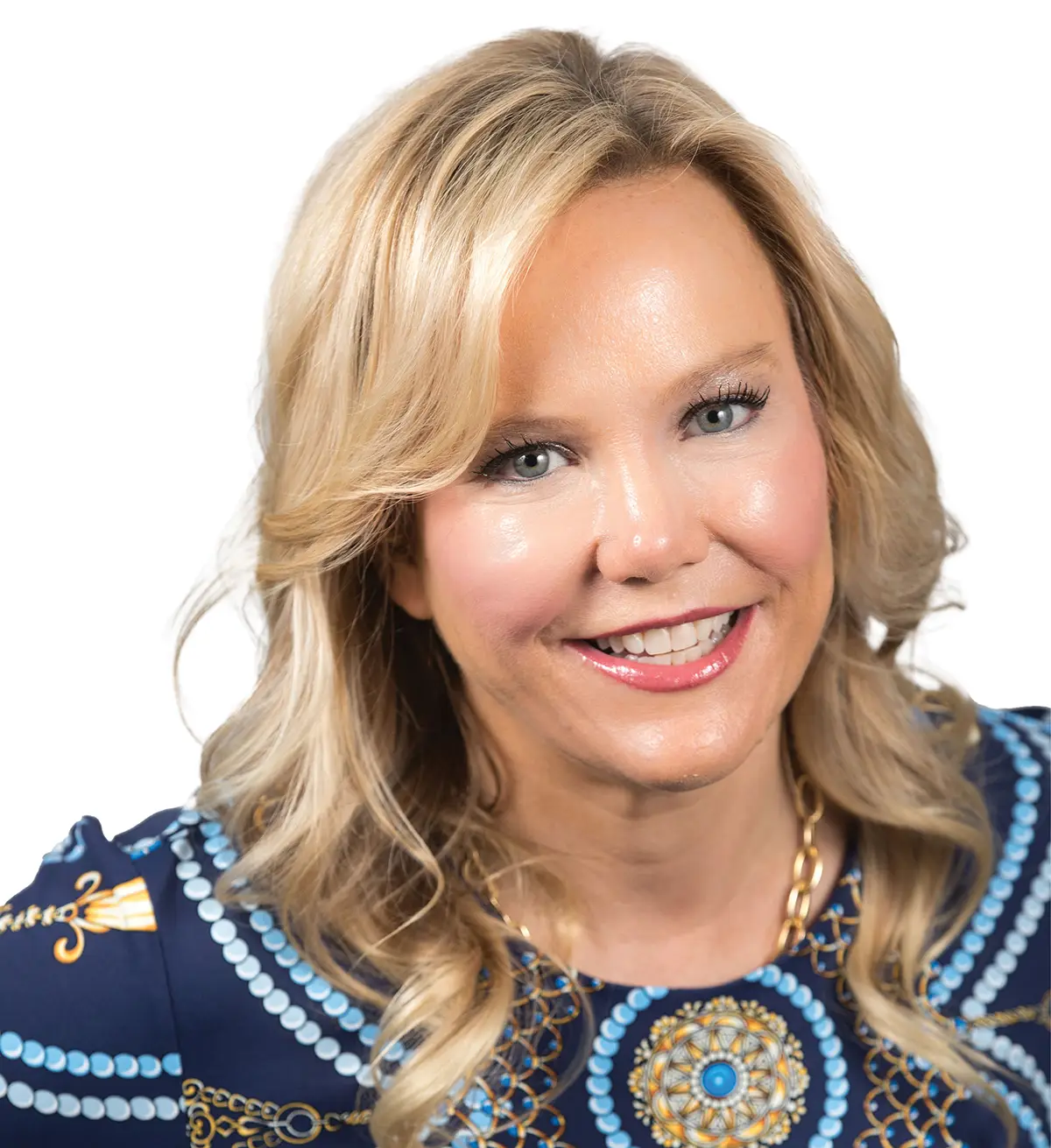
ithin the self-storage industry, there is one rags-to-riches story that everyone should applaud. Unlike social-climb narratives that transpire overnight, this is a decades-long account of perseverance and hard work—a hill that has been ascended through merit.
The Rauns’ church’s generosity was essential to their survival. While her home had many moments of instability, and she always felt out of place as the “poor kid” on financial aid at wealthy private schools, she says that as she has grown older and had three children of her own, she realizes that her parents’ gift of unconditional love and support without a focus on financial success above all else was and is a greater gift than money could have ever provided. With her father only making $80 per week as a pastor, she learned how to identify a “deal” by shopping with her mother and aunt through using coupons and price comparison. She recalls her mother studying the grocery store circulars and planning out their shopping trips based on her grocery list and which store had the best deal that week.
“I wish more women were comfortable investing given so many of us are brilliant at identifying deals online or in the supermarket and yet so afraid to manage our own money and destiny through investing,” she says.
When it was time to consider higher education, she opted to attend the University of Pennsylvania in Philadelphia for a degree in history and was able to attend due to scholarships and financial aid that recognized her academic achievement.
“I remember that there was an ATM machine in the Wawa below my dorm that allowed you to take out cash in increments as low as $10 that I was so grateful for given I often only had that much to take out, even with the jobs I had throughout the school year and summers to help pay for books and my parents’ enormous sacrifice to help pay as much as they could towards my education.”
Her academic excellence was recognized in 1999, when she graduated Phi Beta Kappa and summa cum laude with a GPA of 3.94. Despite going to the University of Pennsylvania and Harvard Business School, she credits her father and mother with teaching her by their actions the most important things she has learned which she has relied on throughout her career:
- People matter more than things or keeping up with the “Jones,” so work at a place for the people and not for the money or a stamp on the resume.
- Treat other people like you want to be treated.
- Honor your word and tell the truth, even when it is hard to do so.
- Doing the right thing is always the right thing.
Naturally, Raun Schlesinger’s next step was to seek employment and put her degrees to work. She typed up a resume, printed a stack, and dropped them off at the recruitment office on campus. “I received nine Wall Street job offers,” she says, acknowledging that it was a “great market” at the time of her graduation. “I think my resolve and energy along with the math classes I took that I got As in enabled them to be comfortable that I could do the math and, more importantly, was a thinker and a hard worker.”
In 2005, after earning her MBA, she joined W.P. Carey (WPC); about a year later, she was co-founding its self-storage investment platform as the firm’s first independent investment vertical outside of triple net lease and helped to raise the initial capital for the self-storage platform. “I had spent nine months studying storage and to this day have not met a business I love more.” She credits her deep, detail-oriented data and analytical focus and time spent digging in and “really doing the work” with why she had the courage to jump into an industry that at the time was not at all the obvious sector to invest in like it has become more recently.
Raun Schlesinger devoted over 11 years to WPC, completing 76 self-storage transactions totaling 155 properties that represented investments of more than $1 billion, before numerous management and strategic changes prompted her to leave WPC. Besides the financial implications of this change, Raun Schlesinger was saddened to depart the business that she had built and that the company was no longer the same as the one WPC’s founder had built.
“We’re a unique group in that we’ve been in the sector for a really long time,” says Raun Schlesinger, who has served on its board of directors since its inception, “and have one of the best track records out there with a very strong reputation for doing what we’re doing and honoring our word.”
Since she had already worked so closely with them for many years, it was easy to simultaneously create a strong, supportive, family-like culture that promotes learning and growth. “I focused on building a company with good values,” Raun Schlesinger says, adding that her core values are of utmost importance when hiring new team members. Raun Schlesinger prioritizes empathy above all else because she has treated and continues to treat everyone she has met in her career as a customer—an approach to which she attributes much of her success.
To ensure she hires empathetic people, she requires all candidates to complete a Caliper test, a talent assessment designed to measure an individual’s personality and cognitive skills to predict future job performance. “When you are buying a facility, it is so critical to understand how emotionally charged it can be for someone who is selling you a facility that they have built with their hard work, blood, sweat, and tears and how important it is to them that you treat them fairly.” That’s something she can relate to quite a bit herself after building two of the biggest self-storage portfolios in the country by sleeping only four hours a night for many years.
Hiring for empathy is a strategy that is working so well for Merit Hill that the company has outgrown its office space for the second time; they recently moved to a larger floor within the same Brooklyn building. In addition to the Brooklyn office, Merit Hill has a Dallas office that was opened in 2017 as well as several team members located across the country for ease of travel across Merit Hill’s national portfolio. Altogether, the team now totals more than 30 employees.
As for business transactions, throughout her career she has looked at more than 10,300 facilities, including 8,292 at Merit Hill alone, and purchased 564 facilities. Of those 564 facilities, 434 have been bought in 271 separate deals since she founded Merit Hill; she has 16 more under contract.
With a portfolio totaling more than 22 million net rentable square feet, Merit Hill is the eighth largest self-storage operator in the United States, but reaching that standing was never a priority for Raun Schlesinger, despite being a workaholic with very few boundaries. “Being big was never my goal,” she says, mentioning that she’s only ever been competing with herself. “I just love doing deals. I’m a head down, work hard kind of girl.”
While many women avoid positions in finance (Raun Schlesinger was one of two analysts at her first job in a male-dominated field) and seem to be fearful of investing, she is enticed by “the puzzle” of deals and thoroughly enjoys figuring out how to make them work for everyone, the seller and her investors. More than anything she loves the people in the self-storage industry and says getting to work with so many hard-working entrepreneurs to create “win-win” deals is her favorite part. However, that doesn’t mean she will piece something together just for the sake of making a deal. She is cautious with investors’ money and would never risk losing their funds because she experienced the disappointment of a bad investment at a young age when she put $1,000 of her own money into a tech internet fund and lost almost all of it.
“It was a life lesson,” says Raun Schlesinger, who learned to always understand the fundamentals before making an investment. “I haven’t been interested in investing directly in tech ever since.” As a matter of fact, she doesn’t even have a presence on social media beyond LinkedIn, which she barely ever checks.
For Raun Schlesinger, the fundamentals of self-storage investments are more clear-cut, and she has found a winning formula for Merit Hill by seeking value-add properties. Though she states that “the devil is in the details,” she looks for facilities that have growth opportunity and a reasonable price per square foot. By identifying the “growth left in an asset,” she can increase its value. Some improvements she and her team may make at a facility include utilizing LED lights, expanding its net rentable square footage (if space permits), altering the unit mix, adjusting rental rates, and hiring Extra Space Storage or CubeSmart to manage the property. She credits Extra Space and CubeSmart and her desire to use them as third-party property managers before many people were doing so with so much of her success in the industry due to their ability to improve operations and help increase revenue at her facilities after she purchases them.
“This is incredibly important these days given how popular storage has become and how low initial cap rates can be, especially in such a high interest rate environment. I always say you are kidding yourself if you think ‘mom-and-pop’ owners are stupid given they are in self-storage, which is an incredible business, and also that they know just how valuable their facilities are and how low their rental rates are compared to the market now.”
So, she buys properties by giving them a ton of credit for upside that she absolutely needs to achieve to make the deals work for her and her investors. “It is basically sharing in the risk and value of the potential revenue growth of a self-storage facility.”
“We will be selling some,” says Raun Schlesinger. “We have to do right by our investors and think of their interests first above all else.”
But no matter the size of Merit Hill’s portfolio, she is certain that she won’t be going anywhere. “I love the people in the industry. The people are the reason I stay.”

Companies, LLC
ut yourself in your customers’ shoes. Take the same journey that your customers must navigate to rent a unit at your self-storage facility. Then, be honest with yourself as you answer these important questions:
- Was it a fast, easy, and convenient experience?
- Approximately how long did it take to secure a unit and move in?
- Could you complete the move-in without assistance? If not, was the customer service you received satisfactory?
- Would you be comfortable storing your valuables at the property?
If you encountered any difficulties or frustrations throughout the rental process, it’s probable that customers, some of whom may be new to self-storage, were/are not completely satisfied with their experience at your facility. In truth, considering that competitors likely exist within the market area, any negative experience could prompt them to rent at another facility—one that provides a better customer experience.
Per Salesforce, 80 percent of consumers believe the customer experience carries as much weight as the company’s product or service. And 54 percent of U.S. customers that PwC surveyed said that most companies need to improve their customer experience. If you’re wondering what matters to those customers, speed, convenience, helpful employees, and friendly service were the most important aspects of the customer experience for nearly 80 percent of PwC’s respondents.
Thankfully, there are benefits to providing an exceptional customer experience. For instance, 65 percent of U.S. customers who responded to PwC’s survey find a positive experience with a brand to be more influential than advertising, and 43 percent would pay more for greater convenience.
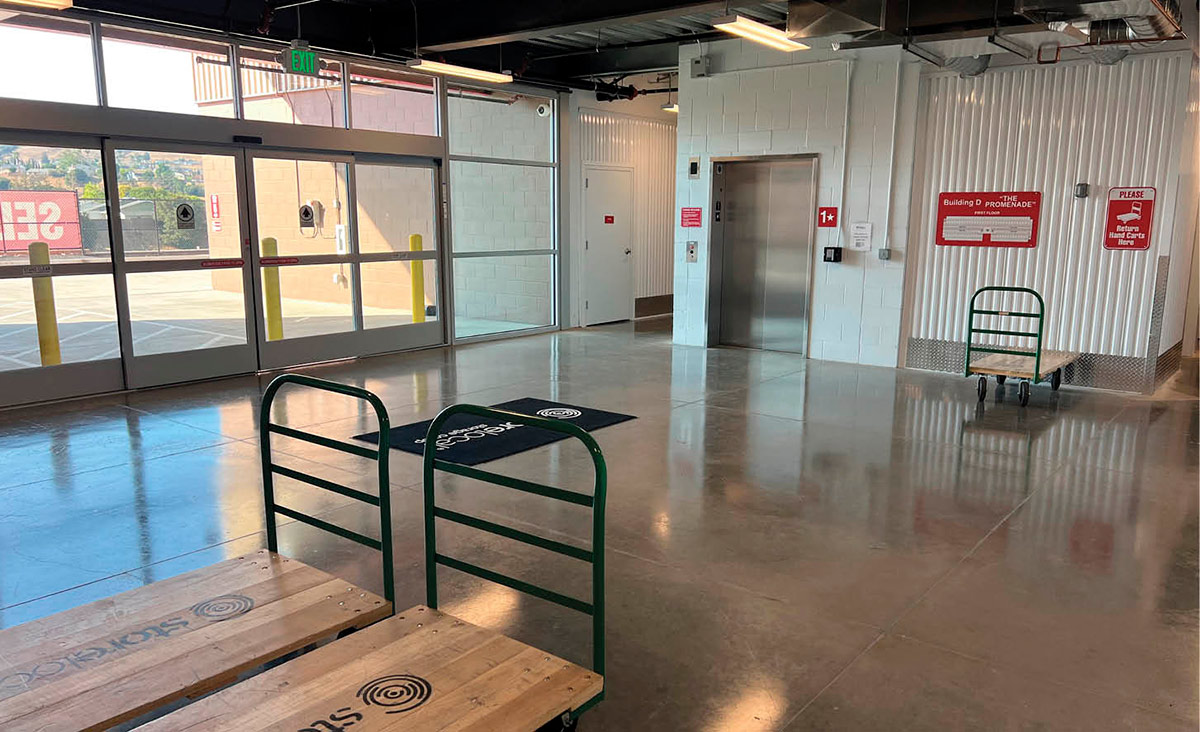
“I believe that the most successful stores provide the best possible customer experience,” says Lorenzini. “The question is: What steps can an operator take to do this?”
In short, he states that operators can enhance their customer experience by focusing on “intelligent facility design,” utilizing “advanced technology features,” and strengthening branding, but all these items require purposeful deliberation.
“When making design decisions, of course we are considering costs,” he says, “but we are always cognizant of how the design will affect the overall customer experience.”
Claremont’s newest self-storage facility, Storelocal Hercules, a 98,298-net-rentable-square-foot, 794-unit property in Hercules, Calif., is a prime example of his laser focus on the customer experience in the design stage of development. Because the lot was approximately 3.5 acres, he knew from the get-go that a multistory building would be incorporated into the project to make it pencil, even though drive-up units are still favored by many customers for their ease of access. Both single-story and multistory buildings were included in the plan, but Lorenzini was determined to make the three-story building as convenient as the drive-up units.
“We wanted to ensure that our customers would have no trouble accessing upper-floor units,” he says. “We designed the building with a large, covered loading zone that can fit two trucks side by side. Customers access the building through automatic sliding glass doors, which open to a huge elevator lobby with two elevators and several over-sized hand carts. I can tell you from experience that our customers truly appreciate the ease of access; it has made it easy for us to fill the upper-floor units and to achieve higher rents on the upper floors.”
To maximize move-in/move-out efficiency, the loading area and unit mix were strategically mapped out. The elevators are located in the center of the multistory building’s loading area, and having one elevator on each side of the lobby minimizes the distance any customer must travel to reach their unit. “Of course, some units are going to be closer than others, and we can price these units higher, based on distance from elevator,” he says. “There is a unit mix strategy whereby the upper floors tend to be smaller units (predominantly in the range of 5-by-5 up to 10-by-20).”
With most of the market’s storage supply being older product, Lorenzini recognized that a high-tech storage facility would standout from the competition and attract contemporary customers. “As self-storage design has evolved and improved, the consumer’s perception of self-storage has also improved,” he says. “But along with this, customers’ expectations have also increased, especially in the age of Amazon one-click shopping. Self-storage is essentially a retail business, and consumers expect nothing less than what they have come to expect from other retailers. Our customers want an experience that is fast and simple and that can be transacted on their smartphone.”
Lorenzini understood that having mobile-enabled access control and contactless rentals would meet customers’ expectations while improving ROI. “With every project, you learn something,” he says. “What we’ve learned is that the technological aspect is huge, especially in recent years.”
He wanted Storelocal Hercules to be the “most technologically advanced facility in the market,” but first he needed to calculate the costs to determine whether his vision was financially feasible for this facility. “Ultimately, it was not a problem,” Lorenzini says, adding that they are able to charge premium prices for its high-tech features, which include a smart lock on every door, an advanced security system, and a mobile-friendly property management software.
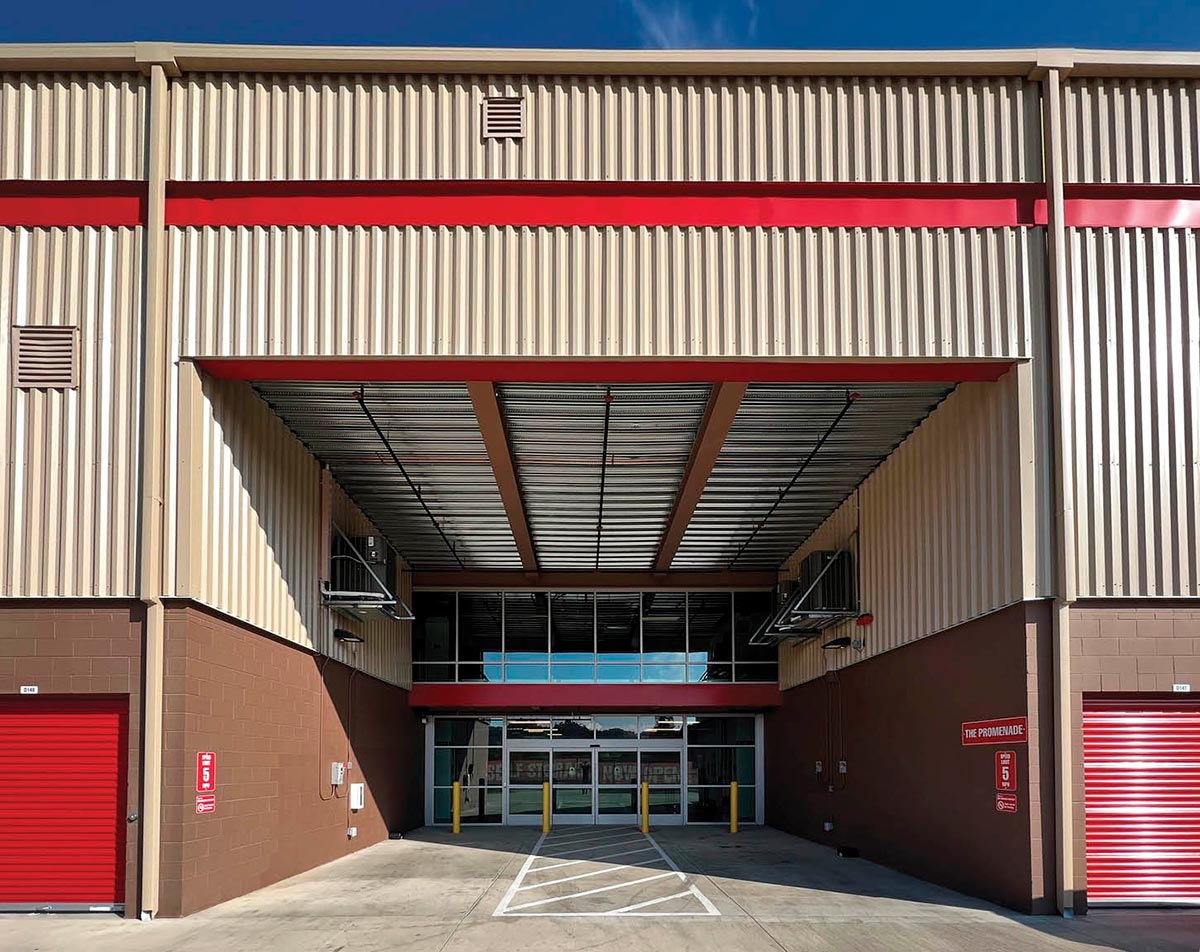
Speaking of smartphones, Storelocal Hercules customers can access the front gate, the elevators, their units, and even the bathrooms with their mobile keys (AKA smartphones). “This truly enhances the customer experience, as there are no more forgotten gate codes and no more lost keys,” Lorenzini says, noting that they use Janus International’s Nokē Smart Entry system, which provides managers with a record of all users who’ve opened access points at any time. “Everything is in an app. The Nokē system has additional benefits such as allowing customers to share a digital key as needed with friends and family. This provides added security as it allows the manager to know who is accessing the facility at any given time. The system also includes a heat and motion sensor in every unit, so that the manager will know if somebody is in a unit after-hours, or if there may be a potential problem. This provides added security and peace of mind for our customers, again, enhancing the customer experience.”
He goes on to say, “The real beauty of smart locks, when integrated with powerful property management software, is that it allows for a completely automated move-in process for customers. Customers are able to rent a unit on their smartphone and gain access to their unit, even after office hours. This level of automation allows us to save money on operational costs. It also allows us to convert more customers.”
With 58 percent of web traffic being conducted on a mobile device, according to Statista, and that percentage expected to increase, it only makes sense to give customers the ability to complete rentals anytime, anywhere, from their smartphone.
“At Storelocal Hercules, approximately 10 percent of our move-ins have been unassisted,” adds Lorenzini. “These are customers that we likely would have lost otherwise.”
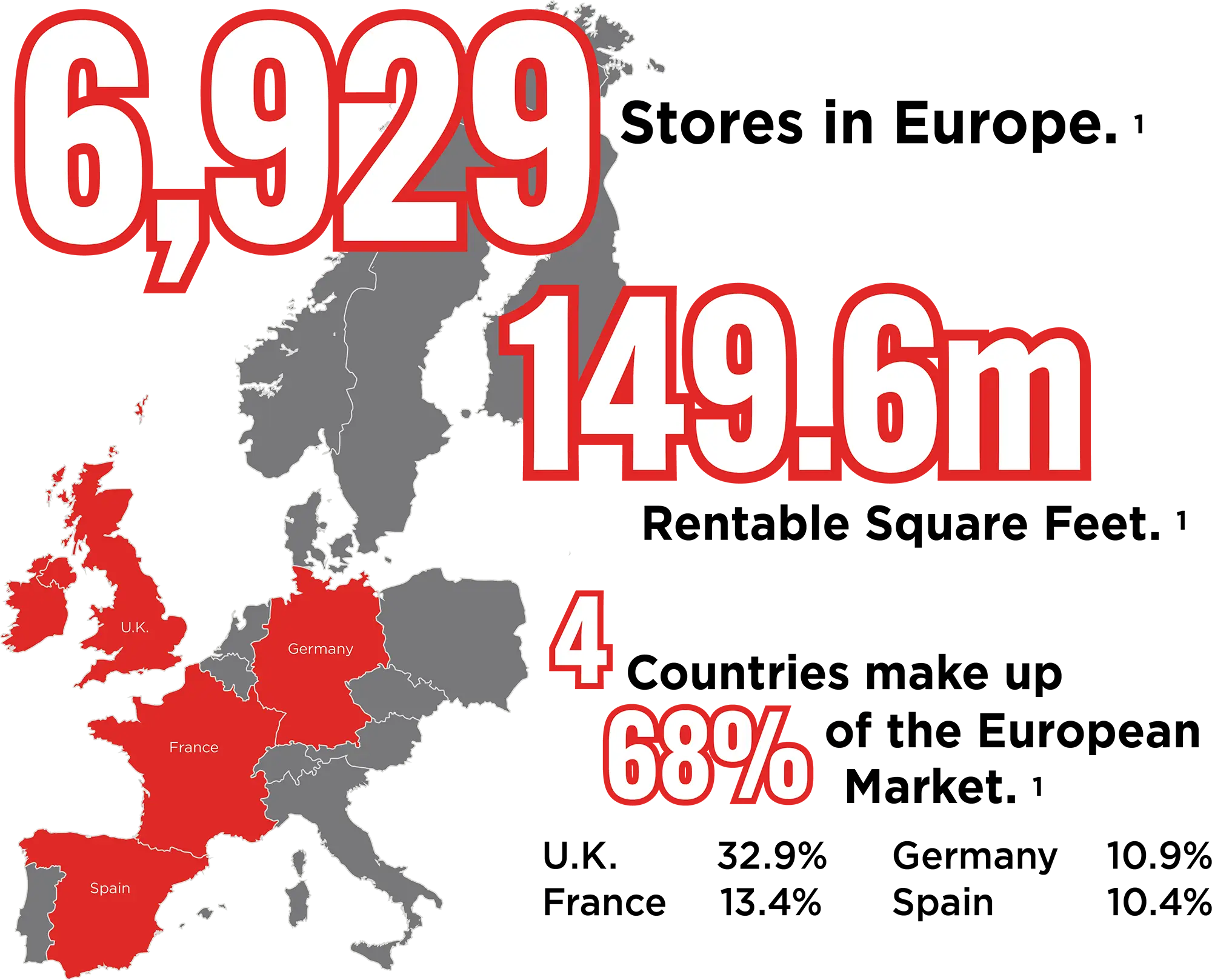

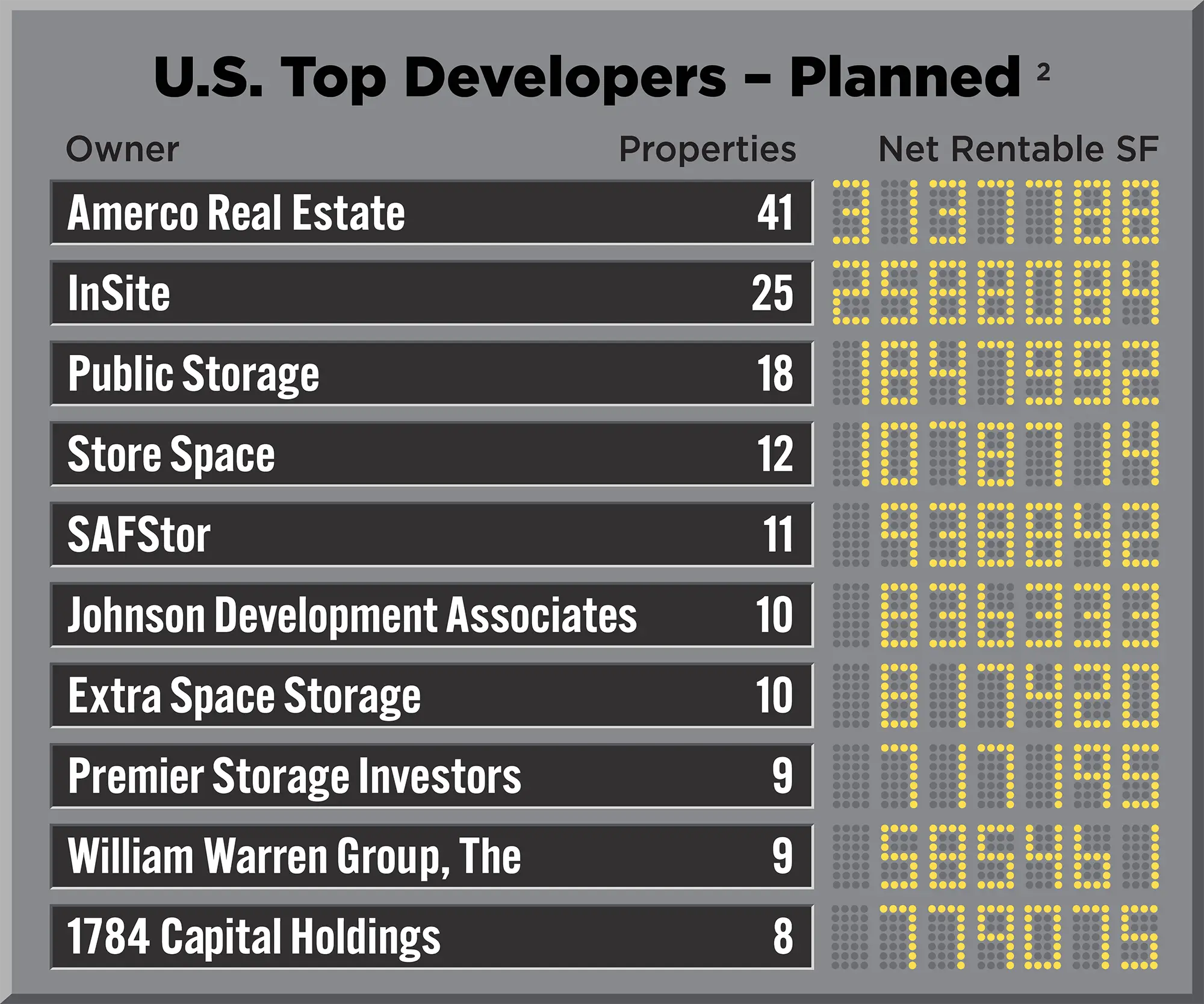
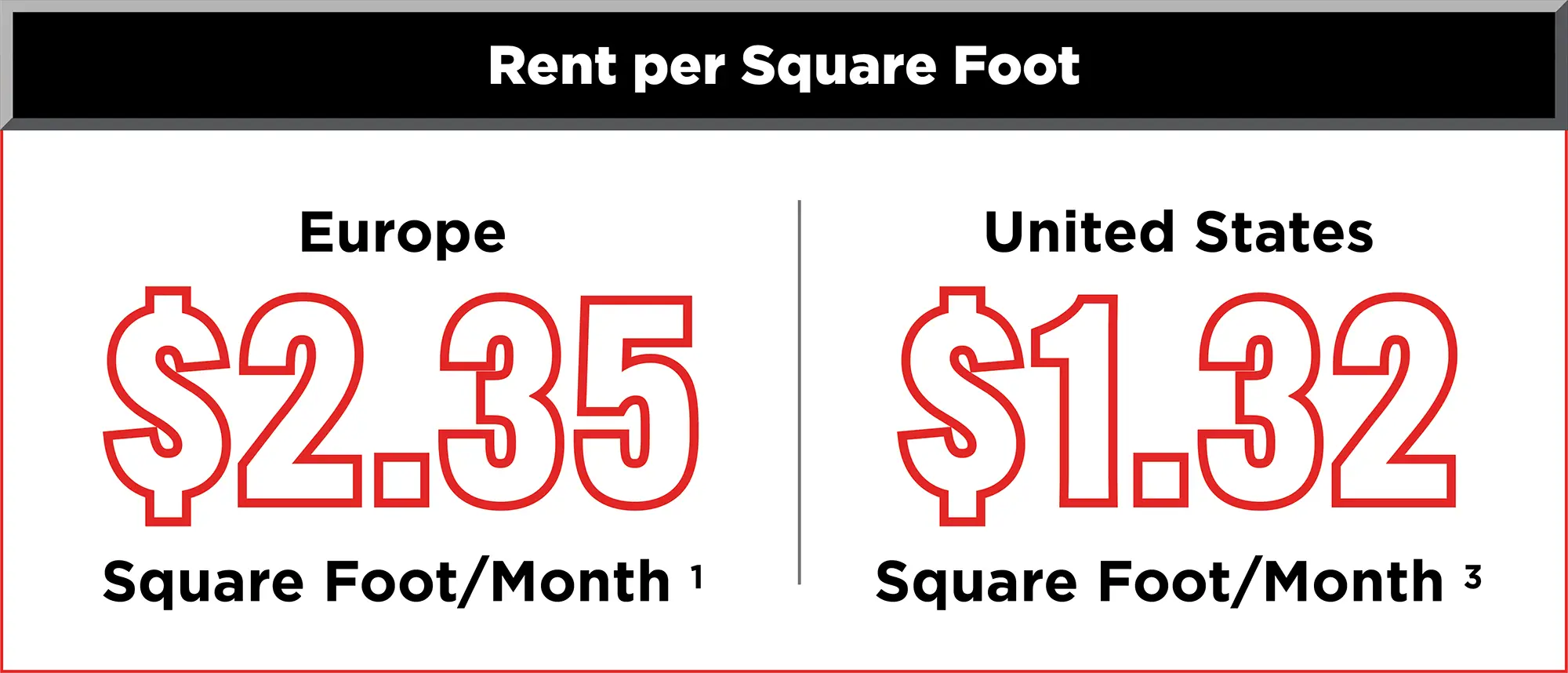
magine going into your doctor’s office and hearing medical jargon when they are giving you test results. Instead of asking questions, you simply get up and walk out of the office, not fully comprehending what you were just told.
“When you’re reading your reports and management summary, it’s just like getting a checkup and reading or hearing the results,” says Carol Mixon, president of SkilCheck Services Inc. in Tucson, Ariz. “You have to know all the terms and understand them to make an informed decision.”
Mixon, who audits facilities, continues, “I wish more owners would learn what they are reading; it can make so much difference in their cash flow.”
In one example, a facility owner thought they were doing great because the occupancy rate on the management summary showed 95.4 percent occupied. However, when studying the summary further, it also showed the Effective Rate After Concessions was $70,826 and 57.9 percent. As well, there were over $300,000 in concessions and 14 tenants needed to be auctioned.
“This may be an extreme example, but these are the clogger of the arteries when it comes to income potential,” says Mixon. “The owner thought the property was doing well because of occupancy, when in fact the store was doing poorly.”
- Same-Store Sales Increase (SSSI) – Measure this at least annually, but it can be measured anytime. Look at last year’s management summary, as well as the year before. Divide the total income last year by the income for the year before. This will give you the SSSI.
- NOI Increase – Measure this at least annually, but it can be measured anytime. Obtain last year’s cash flow statement, as well as the year before, and divide the total net operating income last year by the net operating income for the year before to calculate the NOI increase.
- Gross Potential and Street Rates – If you’re doing rate increases on a regular basis, your gross potential should be going up. Every tenant should be given a rate increase at least annually.
- Insurance Sales – What percent of move-ins are being sold insurance? Ballard says at least 85 to 90 percent of renters should be purchasing insurance, which adds income in your pocket.
- Box Sales Per Lease – What’s the total of retail sales per lease?
- Discount Percent – How much are you giving away in discounts? Those who are getting more than a 50 percent discount should equal the total company or complimentary spaces.
- Fees Waived Percent – Are your managers collecting late fees and other fees or are they waiving them unnecessarily?
- Delinquent Percent – Ballard says it’s very important not to have any delinquency showing in the 61- to 90-day categories. “If managers are processing delinquencies for lien sales at 30 days, you shouldn’t have any delinquencies in this category,” she says, adding that delinquencies shouldn’t exceed 3 to 5 percent of the gross potential. “Anything over that and your store has a delinquency problem.”
- Expense Percent – What is your expense percentage?
- Economic Occupancy and Customer Rates – There are three types of occupancy that must be understood: unit, area, and economic.
Key points of your management summary include:
- Rent vs. Actual Occupied Unit Rates – Do your rents collected equal your contract totals? If not, you need to figure out why.
- Payment Receipts – Add late fees and other fees collected. Under Concessions, add the late fees waived with other fees. Divide waived fees by collected and this number should be less than 10 percent.
- Occupancy – Compare the percent of units, percent of area, and actual occupied unit rates. Are your three types of occupancy in balance? Which is higher?
- Rent Last Change – Add 0 to 6 and 6 to 12, does that number equal your total occupancy? If not, why are there renters who haven’t received an increase?
- Owner’s Alert – This area will tell you if there are things you should be aware of, such as tenants who are not receiving rent increases, as well as deleted units and deleted charges (which may indicate an employee is hiding something off the books).
“The most important part is understanding all of the numbers on the summary,” says Mixon. “Owners, as well as managers, should be learning the software and doing webinars.”
Mixon recommends taking webinars through Sitelink. “They don’t explain how to read the reports, but there are tutorials you can find on YouTube.”
When setting up the software, it’s important for managers to have access, but there are different levels of access; only owners should have “owner” access, which allows them to change unit numbers, etc. “In one example, I had a store I audited that was missing five units,” says Mixon. “The units disappeared from the software and the tenants were paying cash. The units weren’t showing up and the cash didn’t show up as income. The manager was stealing.”
Another step Gibson’s managers do is review the rents at least once a month to make sure all specials are up to date. “We also review these at corporate to ensure no one is giving sweetheart deals,” she says.
With regard to delinquencies, her managers also review the past-due reports at least once a week. “These are the three things we look at regularly to make a determination on how a property can make more money,” says Gibson. “The exception report makes sure managers aren’t writing off late fees and are also increasing rents as they should.”
Additionally, they send emails to each manager monthly. “We tell them where they stand in regard to goals and expectations,” says Gibson. “These emails also outline our support in helping them improve, if necessary.”
- Expect a daily close and balance, bank deposit.
- Expect cleanliness everywhere, no matter how old the facility.
- Expect concise written or digital instruction for all processes.
- Expect standards and goals to be provided for all areas.
- Expect to measure performance daily, weekly, monthly, and annually, and provide at least an annual performance review.
- Expect to succeed with consistent inspections of all areas you deem important.
- Expect marketing or rate management every week or month.
- Expect to see at least a 10 percent improvement.
s with so many other industries, the self-storage industry is on the brink of an evolution as owners and managers seek to harness new tools and technologies to make operations more efficient, cost-effective, and productive.
But are there trade-offs for letting a machine do the work? What are the opportunities and the potential challenges of remote management?
To understand the impact of remote management on an individual business and on the industry as a whole, it’s important to understand the capabilities of this technology as well as the benefits and potential drawbacks.
In addition, technology companies offer a host of other services tailored for self-storage owners to manage their facilities remotely. Some of these services include call centers that are always available to connect a customer with a storage expert; online portals that track customer activity and trends; smart utility systems that optimize thermostats, lighting, and locks; and mobile apps that allow tenants to make online payments and access their account history.
Much of this technology empowers the facility owners. With these systems in place, contracts are digital, enabling termination of storage unit access at the touch of a button when payments are late. Real-time, trustworthy, and valuable data analysis is also readily available to help owners determine when to raise or lower rental rates and how to modify operations.
Ample security technology exists today to ensure customer safety and facility security. Surveillance cameras, alarms, and motion sensors are now standard at most self-storage facilities regardless of on-site or remote management; however, they are vital when relying on technology to facilitate transactions and access. These technologies, coupled with personalized access tools to enter gates and individual storage units, ensure that only valid, registered users enter the facility. Such security features are even more critical in remote or rural markets with less street traffic and lower visibility.
But just because boots aren’t on the ground, it doesn’t mean eyes aren’t watching. Remote management often entails 24/7 monitoring by off-site personnel to monitor all activity within the facility. While requiring personnel, efficiencies are realized as one associate can oversee multiple locations and is equipped with an emergency call button(s) that connects to the appropriate police district or security personnel from anywhere in the world.
See, humans are still needed. But where does technology make the greatest impact?
Remotely managed self-storage facilities also thrive in urban markets where customers typically use automation on a daily basis and are more comfortable with technology.
Installing an automated system ensures that new customers are not turned away and transaction opportunities are not missed. Customers can rent and access storage units as needed, while owners and managers can remotely monitor transactions as well as activity without needing to be on site.
The same technology also permits accessibility to the facility for extended hours, which is important for rural markets with non-traditional work hours and drive-time considerations and urban markets for both work and transportation schedules.
Remote management systems not only give customers access beyond traditional hours, but it also allows operators to lock down a facility when faced with a security issue. Customers can now be protected from known crime, facility operational failure, and other dangerous situations with a click of a button.
Self-storage owners must analyze the total costs of both on-site and remote management options before making the investment. Do the costs to install and operate a remote management system outweigh the costs of ongoing hiring, training, and compensating on-site personnel? The results of this cost analysis vary from site to site, market to market, and even owner to owner; it’s influenced by many factors.
The average cost of implementing a remote management system ranges from $10,000 to $35,000. Initial expenses include purchasing and installing the necessary technology, upgrading existing infrastructures, integrating the automated systems and processes into a facility’s standard operating procedures, and customizing the interfacing digital platform. Managers and employees also need to be trained on the new technology and new procedures.
Once installed, remote management systems also require ongoing maintenance. As with all other technology, regular upgrades and servicing are needed. Periodic hardware upgrades also may be required to comply with industry and regulatory evolutions. Also, most technology platforms require a monthly or annual subscription cost for call centers, surveillance, and video monitoring.
Now, compare this investment to the average cost of personnel to operate on-site management. According to Franklin Street’s Senior Analyst Zach Levine, the cost of self-storage staffing and personnel averages $1.10 to 1.50 per net rentable square foot, depending upon facility size and number of employees. Staffing includes managers to oversee each facility and complete rental transactions, custodians to clean and maintain the common areas, and security guards to monitor the site. In addition to employee salaries and benefits, the cost of hiring and training must also be considered.
Not only can these systems reduce the need for personnel on site, but these sophisticated systems also offer a wealth of valuable data. As facility activity is tracked, valuable data on customer usage is compiled that can ultimately advise on important operational decisions.
Analysis of usage rates, rental transactions, customer visits, and other data can inform owners of well-timed and potentially lucrative strategies. For instance, when to:
- schedule facility maintenance to avoid minimal customer inconvenience,
- adjust rental rates to align with supply and demand and market factors,
- plan for expansion and the optimum unit size to be added,
- schedule employees to align with traffic patterns, and
- increase security to ensure safety of both customers and personnel.
Likewise, the dawn of remote management technology has broadened the investor pool for the self-storage sector. No longer must owners be located within the market or even within the state. This has led to the growth of a middle market filled with private owners with portfolios across a region or stretching coast to coast in an industry once dominated by either institutional investors with vast platforms or “mom-and-pop” owners of one to three facilities in a single city.
Particularly in today’s market, with downward pressure on rental rates, it is more challenging to justify increased rental rates without the cost (and benefits) of on-site personnel, making it more difficult for a remote management strategy to succeed.
For those facilities where remote management systems are deployed, many operators have reported savings of at least 10 percent. But there are no guarantees. There are also facilities that have lost customers (and subsequently revenue) due to the lack of on-site personnel to address challenges and concerns with immediacy. While call centers can respond within minutes to an inquiry, associates have limited knowledge of the market, the facility, or even the unit. How could they from overseas?
For more institutional owners, and those with larger portfolios, deploying remote management systems has the potential to negatively impact the valuation of a facility. For those owners that rely upon the personal touch and face-to-face interactions as differentiators and brand cultivators, using automation could weaken market position and detract from intrinsic value. And a drop in occupancy ultimately reflects in a drop in asset value.
For instance, for customers with questions, who encounter technical challenges or have complicated needs, frustration is possible and could lead to the ultimate cost of a losing a customer. While computers and machines are efficient and cost-effective, addressing problems and seeking solutions requires the power of human connection.
Also consider that not everyone is digitally connected. Although technology seems to have infiltrated all aspects of our lives, not everyone relies upon it or is comfortable operating on a digital platform. For many, it’s easier to have a conversation or shake a hand. These consumers will be challenged with online booking system, self-service kiosks, digital access gates, mobile apps, and other automated processes. Well-written directions with visual cues may help to overcome these obstacles.
With all technology, the concern of cybersecurity threats, data breaches, and other issues is real. Data such as customer credit card numbers and personal information stored in the cloud must be protected with robust security measures. The investment to protect user data and ensure that automated systems are not hacked or otherwise compromised is significant and must continually be upgraded.
So why has remote management technology emerged so quickly within the self-storage marketplace? By limiting costly overhead and informing efficient operational strategies, the deployment allows investors to underwrite more aggressively due to a lowered expense load. By doing so, the acquisition of smaller facilities is made possible, opening up a previously locked asset class where investors can leverage more due to less costs.
Ultimately, it takes careful analysis, thoughtful adoption, and intelligent monitoring and analysis, both of people and technology, to bring the best management solutions forward. Self-storage operators who strategically and carefully harness the power of remote technology can craft an efficient, convenient customer experience that just might surpass the upside of personal interaction.
n the 1989 film “Gleaming The Cube,” Brain Kelly, a 16-year-old skateboarder played by Christian Slater, defines gleaming the cube as “pushing your limits to the edge.” Perhaps no one has a better grasp of that obscure phrase’s meaning than Mikey Taylor, president and managing principal of California-based Commune Capital, a private equity real estate investment fund. He has been grinding (figuratively and literally) to outdo his objectives since he started skateboarding when he was 13 years old.
“There was a part of skateboarding that really changed the way I looked at the world,” says Taylor. “I never looked at a handrail to be used as anything other than the means to help you walk down or up stairs. When I saw somebody skate on a handrail, everything changed.”

n the 1989 film “Gleaming The Cube,” Brain Kelly, a 16-year-old skateboarder played by Christian Slater, defines gleaming the cube as “pushing your limits to the edge.” Perhaps no one has a better grasp of that obscure phrase’s meaning than Mikey Taylor, president and managing principal of California-based Commune Capital, a private equity real estate investment fund. He has been grinding (figuratively and literally) to outdo his objectives since he started skateboarding when he was 13 years old.
“There was a part of skateboarding that really changed the way I looked at the world,” says Taylor. “I never looked at a handrail to be used as anything other than the means to help you walk down or up stairs. When I saw somebody skate on a handrail, everything changed.”
Taylor landed his first sponsorship deal with Duffs Shoes when he was a junior in high school and began making approximately $800 a month as an amateur skater. He turned pro at 19, earning a six-figure salary by the time he was 24.
“I had no idea it would be a career,” says Taylor. “My original plan was to skate for maybe a few years and then go back to college. And then at that point, skateboarding just exploded.”
Instead of attending law school, he skated until into his early 30s—longer than he expected. As a professional skater he traveled to Spain, China, Japan, and South America to compete in The X Games, ESPN’s extreme sports competition. Throughout his career, he held lucrative sponsorship contracts with DC Shoe Co., GoPro Cameras, and Alien Workshop; he also had over 100 signature skateboard decks and seven pro-model shoes.
When he decided to pursue a career as a professional skateboarder in lieu of a secondary education, Taylor’s parents weren’t exactly thrilled. Because he would be forgoing a degree, and no one knew how long his pro-skating career would last, they encouraged him to speak with a financial advisor for investment strategies that could enable him to have a fruitful future after retiring from the sport.
“One hundred grand as a professional skateboarder doesn’t feel like one hundred grand in a more conventional career because our careers are so short,” he says. “Maybe by 30 it’s over.”
With expert guidance from Randal Sanada, a family friend and financial advisor, who’s “like a big brother” to Taylor, he managed to avoid bad debt, build credit, control expenses, save money, and make astute investments. “He taught me how to budget; he taught me about paying myself first, and then what to invest in,” Taylor says. “He taught me how to look at an investment through the lens of risk and return.”

Taylor wasn’t well-versed in real estate at the time, but he was able to learn what he needed to know from Sanada and his brother, Jerry, who ran RESOP, LLC, a private equity firm with self-storage facilities in its real estate portfolio, and now serves as the CFO and co-president of Commune Capital. His first investment into self-storage was $40,000 into RESOP in 2014, followed by another investment in 2015 of $340,000.
“The first few things I learned was building storage is cheaper than multifamily,” says Taylor. “That price increase isn’t as much of a pain point as other assets. It takes longer to stabilize, and most cities push back on repurposing assets into storage.”
When quarterly dividends from his real estate investments began rolling in, Taylor was hooked. “I became hellbent on the idea of getting to financial freedom through real estate investing,” he says.
To receive higher returns, he curbed his spending and ramped up his investments. Taylor invested about four-fifths of his skateboarding salary into real estate. “I was probably living off $20,000 of it and then just putting as much as I could after taxes into investments.”
In addition to real estate investments, Taylor and two partners utilized investor fundraising to start a brewing company in 2012. They sold Saint Archer Brewing Co. to MillerCoors three years later; at the time of the sale, it was valued at more than $35 million.
He used his share of the profit to make more real estate investments and launch Commune Capital. “We went through a merger in 2021 with Commune and Sanada’s two companies, ABLP [Asset Backed Lending Portfolio] and RESOP [Real Estate Special Opportunity Portfolio]. I had made passive investments into both of those portfolios,” Taylor says, “and when we merged, they became Commune! When I first started investing in RE, I was looking for mostly growth. I wanted to invest in adaptive reuse or redevelopment opportunities. I also wanted assets that performed well during economic downturns. Since I was investing passively, I wanted to trust the operator; they needed to have experience, and I wanted access to the decision makers. I’m still pretty young, so I still have a focus on growth, but we are very heavy in multifamily as well as storage.”
“Business, for the most part, is just a bunch of problems, and it’s your ability to get freaked out by those problems and then solve them over and over and over and over,” says Taylor. “It never gets easier, but there’s a comfort with chaos that came from skateboarding.”


















“Our current multifamily fund (FUNDV) has a little over 100 units being developed in California,” he says, noting that the total cost is around $50 million. The firm, which is currently building its eighth self-storage location, self-manages one facility in Saticoy, Calif; Life Storage and CubeSmart manage its six other facilities in Connecticut, Illinois, Iowa, Ohio, and Washington.
He favors investing in self- storage because it cash flows well but admits that it has become more difficult to find distressed assets and rezone and repurpose them. “It feels saturated now,” says Taylor, adding that investors and developers must “hustle to look for deals” or “get creative with deals.” Alternatively, residential is undersupplied and multifamily has a “lot of deal flow. Cities love it.”
He goes on to say, “First and foremost, we want a location that has demand for storage. We’re looking at how many other storage units are in a one-, three-, and five-mile radius. We look at overall market occupancy and what rents have done over the past five years. We look at the major employers in the area and want some diversity in industry for them. We want population growth, and we’re looking at the median household income. Our newest storage facility is in Indianapolis. We are adding 1,191 units. We start construction Q1 2024 an it should be complete Q4 2024. The purchase price was $7.5 million and total cost $18.9 million.”

Thanks to his drive and numerous real estate investments, Taylor was financially free at 33—roughly 15 years after he first invested in real estate. And his financial freedom could not have come at a better time. In 2016, about a year after he hit that momentous milestone, he sustained an injury that put his pro skater status up in the air. Taylor tore a ligament in his leg that required surgery; then, his sponsor, DC Shoes, let him go two months post-op. With four more months till he could return to skating, he had two options: find another sponsor after recovery or quit skating professionally. He chose to heal and focus on his energy on growing his family, business, and social media presence.
“On some of these platforms, I have a bigger following than I had when I was a pro skateboarder,” he says, adding that he aspires to grow his audience base and eventually have 100 percent of Commune Capital’s equity capital coming from social media.
Taylor recalls encouraging them to invest in a new self-storage offering that popped up after his initial investment and some of their “eyes glazed over” when he discussed the specifics of investing to bring in passive income and eventually exit out of skating. “They thought it was boring. I was selling storage first, and that’s not ‘sexy,’” he says, “but financial freedom is!” However, his message did resonate with two other pro skaters, Paul Rodriguez and Sean Malto, who followed his advice and invested.
He’s since realized that their perplexity was related to the financial aspect of his proposal, not self-storage, which is why Taylor began teaching financial literacy through social media. He also believes people should be learning about how to invest in money long before they are working adults. As a father of four, Taylor is interested in getting several other educational projects off the ground: a board game and curriculum materials for each grade level—all of which would help children learn about money and understand financial concepts they may use later in life.
“When I looked around at where I thought my skillset could add value to our community, city council was the one that I thought was the best fit,” says Taylor. The position has enabled him to work with the planning commission, to which he’s offered advice about a proposed self-storage facility. “It’s good to see the other side of development,” he says about zoning, approvals, and urban planning. “I have a better understanding of the process.”
efore skating off to watch “Gleaming The Cube,” let’s hear what Mikey Taylor thought about the film!
Taylor: I watched it a bunch of times as a kid, but I wasn’t even a skater back then. We just thought the movie was kool!
MSM: What is your favorite part of the film?
Taylor: When Christian Slater built the dream board with the metal grip, ha!
MSM: As a skater, did you ever use the term “gleaming the cube?”
Taylor: No, we didn’t.
MSM: How are you “gleaming the cube” at 40 years old?
Taylor: My life these days would probably appear pretty boring for young skaters, ha. I’m in the office around 7 and leave around 5. Get home, spend time with the family, put the kids to bed, maybe work a little, and repeat all over again the next day.
MSM: Would you recommend it to our readers?
Taylor: 100%
MSM: What’s your go-to skateboarding flick?
Taylor: My favorite film of all time is “Mouse!”

efore skating off to watch “Gleaming The Cube,” let’s hear what Mikey Taylor thought about the film!
Taylor: I watched it a bunch of times as a kid, but I wasn’t even a skater back then. We just thought the movie was kool!
MSM: What is your favorite part of the film?
Taylor: When Christian Slater built the dream board with the metal grip, ha!
MSM: As a skater, did you ever use the term “gleaming the cube?”
Taylor: No, we didn’t.
MSM: How are you “gleaming the cube” at 40 years old?
Taylor: My life these days would probably appear pretty boring for young skaters, ha. I’m in the office around 7 and leave around 5. Get home, spend time with the family, put the kids to bed, maybe work a little, and repeat all over again the next day.
MSM: Would you recommend it to our readers?
Taylor: 100%
MSM: What’s your go-to skateboarding flick?
Taylor: My favorite film of all time is “Mouse!”

ears ago, I wrote about the merging of portable storage and self-storage. At the time, the notion of using portable or relocatable storage units within self-storage facilities was new. However, the line between portable and self-storage has become increasingly blurred over the past decade. The rise of storage in general, coupled with changing customer needs and economic conditions, has led to more interaction between these industries. Despite their functional differences, the portable and self-storage industries share commonalities in terms of convenience, economy, and innovation. And the key element that unifies them is the storage container itself.
By leveraging the capabilities of the storage container, the portable and self-storage industries can provide a solution that caters to a wide range of markets. Various rental methods are already shared among these industries. For example, a self-storage operator might use a moving truck, a moving company may employ portable storage containers, a portable storage company might offer on-site self-storage, and a self-storage facility could use relocatable storage units instead of permanent structures. This article explores the convergence of portable and self-storage industries and highlights the advantages and opportunities of a hybrid storage model.
There is a growing demand for a storage unit that combines the benefits of portable and self-storage. This shift in customer preferences, along with the increasing overlap of commercial and residential customers, necessitates merging these options to provide a unified storage solution. One example of the hybrid storage model is what we call a relocatable unit. It is durable enough for relocation, flexible to fit in unconventional spaces, and customizable to match a business’ existing aesthetic. To provide customers the best of both worlds, you could offer both portable storage units and self-storage units at your facility. Businesses that have hybrid storage offerings will be able to cater to a broader range of markets and help fill today’s storage demand.
Compared to full-service moving, portable storage options offer a more affordable alternative. While it places more responsibility on the customer, this option is gaining popularity due to its lower cost and reduced involvement. Portable storage is a storage option that allows you to store your belongings in a container that is delivered to your location for loading and unloading. You can choose to keep the unit at your location or have it delivered elsewhere. Portable storage units are weatherproof and secure, and they come in a variety of sizes. The units will typically have swing doors with secure locks. They are designed to be easily moved from one location to another by truck, rail, or ship, and some containers may even have wheels or other mobility features built in.
In the self-storage realm, market demand is driving additional development within storage facilities. People need to store more things! The self- storage option is where you rent a storage unit at a fixed location that you can access during the facility’s business hours, usually by driving directly up to the unit. Self-storage operators can build or expand a facility using permanent buildings, relocatable self-storage units, or a combination of the two. Using relocatable units will provide savings in terms of coordination, lower costs per square foot, and time compared to traditional single-story or vertical storage buildings that require extensive permitting and local zoning knowledge. Construction materials are expensive, permitting approvals are slow, and labor shortages exist. Additionally, classifying relocatable storage units as equipment allows self-storage operators to benefit from tax advantages like the Section 179 tax deduction.
Designed to be moved from one location to another, relocatable storage units can be placed and assembled at a facility with little-to-no foundation or major site preparation. They are durable, weatherproof, secure, and beautiful. They are made of steel and come in a variety of sizes to accommodate different storage needs. So, when a brick-and-mortar self-storage facility needs more rentable space, it is easy to add relocatable units. Relocatable storage units can be used side-by-side to create an effective and efficient drive-up or walk-to storage operation. Some relocatable self-storage manufacturers will even help you design the layout for your site to see just how many units you can fit on your property.
The best storage units serve multiple purposes. Portable storage and relocatable self-storage units are used in several ways, and people are taking advantage of their versatility. The hybrid storage model combines convenience, economy, and innovation to meet customers’ evolving needs. Businesses embracing this approach can thrive in the changing storage landscape and provide comprehensive solutions to diverse customers. By staying adaptable and leveraging the advantages of the portable and self-storage industries, storage businesses can position themselves for success in the future.
elf-storage development is an expensive gamble.
A methodical approach greatly reduces risks and increases the odds of success. That starts with finding the right site. But what constitutes the right site?
That question has a multipart answer, several industry experts say.
“However, you’re looking at spending $10,000 on a feasibility study for a project that might cost $10 million to $15 million,” he says. “It’s money well spent to manage the risk.” David Dixon, Atlanta-based Universal Storage Group’s COO, calls the cost of a feasibility study “a rounding error” compared to a project’s total cost.
“I personally would not go into any endeavor without having another set of eyes on it to check the market conditions, occupancies, the rates, saturation points, and the viability of zoning,” Dixon says. “Developers understand the necessity of the studies. Lenders won’t move forward without it.”
Universal doesn’t do “desktop” feasibility studies, says Sarah Beth Johnson, Universal’s director of sales. Those studies are limited to online research. Instead, the company first gets the address of the site in question or a place near it and “looks from 30,000 feet [to decide] whether the feasibility study is worth it,” Dixon says. With this first step, “I always say we can’t necessarily give you a really good ‘yes,’ but we can give you a good ‘no,’” Johnson says.
Universal does a two-phase feasibility study. The first phase is to assess supply and demand. They send someone to “shop the market,” look at the conditions, and judge the site. If everything looks right, then they’ll engage an architect to do some preliminary floor plans to get a unit mix. They don’t engage a civil engineer at this stage because “they’re very expensive for the feasibility,” Dixon says.
Cecelia Parra agrees that a feasibility study early in the process is very important. Parra is vice president of Noah’s Ark Development, a business unit of The Parham Group, based in Bulverde, Texas.
The feasibility study determines whether self-storage demand exists in the market in question, says Rachel Parham, president of Noah’s Ark Development and NDS Construction, another Parham Group business unit. If demand exists, then the details enable them to decide what unit mix they’ll design and build.
Charles Plunkett, founder and CEO of Capco Steel Inc. and Capco General Contracting, based in San Antonio, Texas, says for the typical developer—excepting “an extremely seasoned developer or a big REIT”—a feasibility study is “probably the most important thing.”
Plunkett has been in the business for 38 years. He has seen developers who get partway into a project, get excited about it, spend $50,000, “and get blinders on,” even when it’s not a viable project.
“They want to press on,” Plunkett says. “My thing is developers are eternal optimists. The glass is always half full. A third party gives a detached opinion, an unbiased opinion. They’ll be cautious. A third-party feasibility study is the cheapest insurance policy you can buy.”
A typical self-storage project will require the developer to spend $25,000 to $50,000 before they know whether the project will work. “That’s the price of development,” Plunkett says. “If you can’t afford that, you have no business being a developer.”

Even with the feasibility study in hand, developers should “continue to pepper the feasibility company with questions and continue to study the market, reach out to city officials, and compare timing with other projects coming up in that area,” Williams says. “It takes constant study.”
Parra suggests learning about other facilities in the market and their lease-up rates. Track planned facilities in the development pipeline and cross-reference it with municipal data, such as permits granted, planning, and zoning committee meeting minutes.
“Where’s the traffic coming from and going?” Plunkett asks. “Typically, people rent storage close to home. It’s not an impulse buy. In the old days … 75 to 80 percent of traffic came from drive-bys. Now it’s by looking it up online. Figure out the demographics, income. People with big houses generally don’t rent storage.”
But building a facility near a major road or highway is still better than having a “really strong three-mile radius where all the tenants are coming from,” he says. “You’re reaching out five or even 10 miles.”
Plunkett says the ideal location for self-storage is on the edge of the main business district near residential housing, on a corner with two access points and slightly elevated, in an area with daily traffic of 100,000 vehicles, and near a school because “everybody in the area is bringing kids to school and will drive by.”
“That’s the perfect site,” he says. “How many of those factors can I get?”
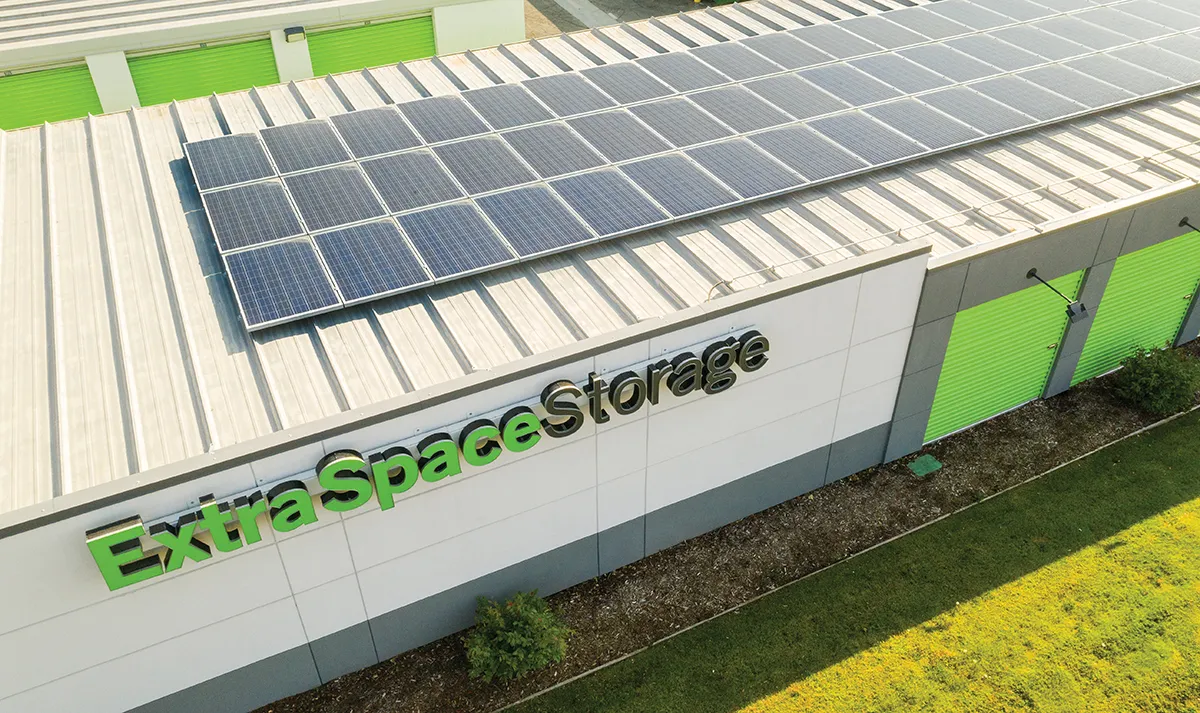
Most deals Williams has seen recently are structured with a two-stage contingency process through the land’s purchase agreement. The first phase is generally more legal in nature. It includes an American Land Title Association survey, easements, liens, and hazardous materials. The second phase involves entitlements, working through site plans, elevations, city approval, landscaping, a geotechnical survey, an architect, a zoning lawyer, a civil engineer, and contractors for conceptual budgeting.
“The most successful projects have all these early in the process,” Williams says. “The feasibility starts when an owner finishes general real estate due diligence, which is usually 30 to 60 days from a contract escrow.”
Whether the developer has experience with self-storage, or they hire Plunkett’s company to make “a roadmap for them,” the team is fundamental. First, get a contract on the site with a specified due diligence period. Assess entitlements and hire an architect and a civil engineer.
“Those unseasoned developers don’t understand the whole process,” Plunkett says. “If you think the site is good and the price for land is good, then have the feasibility study done. A smart developer would bring in a contractor and maybe architect at that point. It takes time for feasibility study. Proceed with what you can do during that time. Maybe spend a little bit of money for an architect to draw up a preliminary site plan.”
A developer needs a reasonable estimate of the cost to build the project, adds Plunkett. Utilities or soil problems can bring unexpected costs.
Site work causes most construction budget overages. Stone in the soil, bad soil, or drainage problems can be the culprit. Capco “missed by a million bucks” on its budget for a project five years ago in Franklin, Tenn. “We had to haul 700 truckloads of dirt out,” says Plunkett. “It’s possible to miss something even with diligence. Tell your geotech guys to over-bore. We called for 13 borings on that site. If we had done 20, we would’ve found it. Our $7 million budget turned out to be $8 million.”
“But people are still getting deals done,” says Williams. “It goes to reputation.”
Dixon hasn’t seen as many new developments planned or being built as there are now since 2007.
“Occupancy and rates are falling,” says Dixon. “Move-ins are good. Move-outs have increased 20 percent. Saturation is coming. I thought interest rates would slow development down, but they haven’t.”

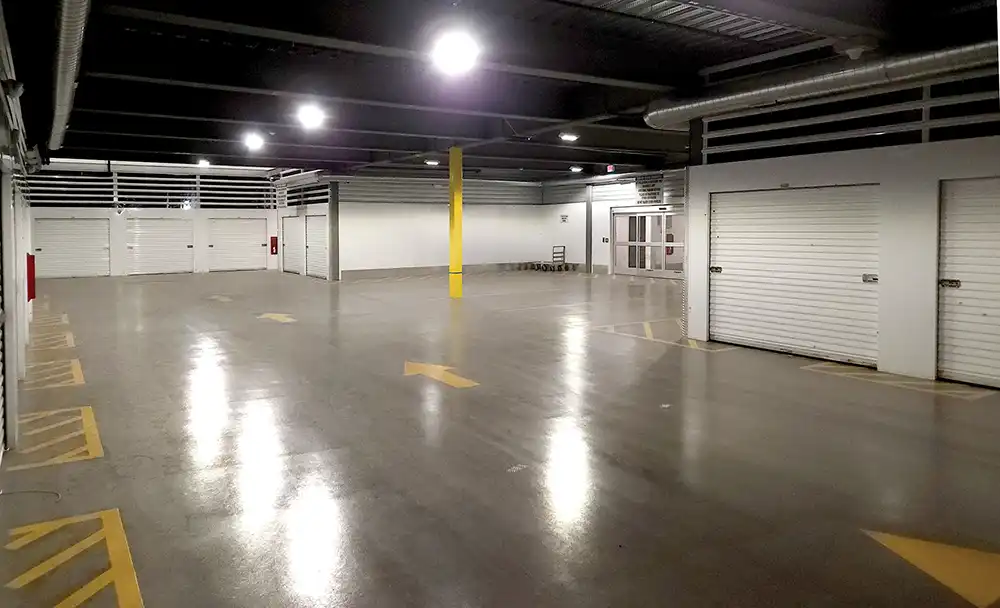

fter approximately two years under development, Arizona Self Storage, a state-of-the-art, Class-A facility prominently located on the corner of the Olive Business Park in Peoria, Ariz., received a temporary Certificate of Occupancy in October 2023. Designed by RKAA Architects, Inc., and constructed by Campbell Development, the brand-new, sturdy square structure has a Lego-like façade with vertical and horizontal elements that create a sophisticated layered design as well as two two-story corners of windows that add to its overall curb appeal.
With three above-ground stories and a basement level, Arizona Self Storage houses 875 air-conditioned units and a fully enclosed, drive-thru loading bay within 115,202 square feet. “Customers can shut the doors behind them and be completely out of the elements,” says RKAA’s Neil Feaser. “This is a special, unique feature that most facilities rarely have.”
Other customer conveniences include Janus International’s Nokē Smart Entry system, multiple freight elevators, daily access hours, online rentals and payments, an on-site resident manager, and ample parking surrounded by a block wall that replicates the striping of the facility’s exterior. Arizona Self Storage is owned and managed by Mangat Investments and Aberdeen Management & Development.


ome industry experts say that self-storage investors are lowering their expectations for returns amid the continuing tough economic environment.
But self-storage is still positioned as the strongest class of real estate compared to the traditionally main types (multifamily, office, industrial, retail, and hospitality).
Steve Mellon, senior managing director of Houston-based JLL Capital Markets, says requirements for investor returns have risen because of rising interest rates, which cause the cost of capital to increase.
“We have seen the cost increase not only for the private capital buyers [mom-and-pop operations], but even the national REITs’ cost of capital increased substantially over the last 12 months,” Mellon says.
Amid several interest rate increases in the past year and a half, the Federal Reserve System’s Federal Open Market Committee (FOMC) said on Sept. 20 that it would hold the federal funds interest rate steady at 5.25 percent to 5.5 percent. The federal funds rate is the overnight interest rate commercial banks charge one another to borrow or lend extra reserves. The federal funds rate also can affect short-term credit card and consumer loan rates.
The FOMC also says it still aims to reach maximum employment and a 2 percent inflation rate in the longer run.
“Recent indicators suggest that economic activity has been expanding at a solid pace,” the FOMC statement said. “Job gains have slowed in recent months but remain strong, and the unemployment rate has remained low. Inflation remains elevated. The U.S. banking system is sound and resilient. Tighter credit conditions for households and businesses are likely to weigh on economic activity, hiring, and inflation. The extent of these effects remains uncertain. The Committee remains highly attentive to inflation risks.”
Investors are also lowering their return expectations, but even lessened returns exceed other real estate classes, he says.
“It’s a pretty bleak story for all of commercial real estate because of rising interest rates,” Mellon says. “But bad news for storage is a lot better than for retail and hotels. We’re cooling to 3 percent [rent increase rates] from 10 to 15 percent. But retail and office guys say, ‘You mean you’re still growing? We’re going backwards 40 percent.’ This will just be another time that storage will prove to be recession resistant. Storage will show why it’s a great asset class during a recession.”
Self-storage as a class of real estate is relatively new, Mellon says. It “really took off” in the 1990s and became a relevant real estate sector. The financial carnage in 2008 and the onset of the COVID-19 pandemic both tested the self-storage sector among all others. But self-storage had the second-lowest foreclosure rate in 2008 behind mobile home manufacturing, and it performed well during the onset and worst of the pandemic.
Because of uncertainty about future interest rates, JLL expects investors to focus more on assumptions about future rental rates that they can come closer to proving today rather than in the future, he says. But he adds he’s optimistic that the construction slowdown will help self-storage in the long term. Most owners will say the one thing that affects their stores the most “is a competitor opening down the street.” This generally should help existing properties’ future cash flows.
The recent acquisitions by Extra Space of Life Storage and by Public Storage of Simply Self Storage—transactions valued at roughly $15 billion combined—“have propelled the self- storage sector to the lead in 2023 deal-making as of July 31,” Chilton says.
“After record-level fundamentals in both 2021 and 2022, a return to normalcy seems evident thus far into 2023. … Record low mortgage rates early in the pandemic brought elevated home sale activity and moves away from coastal urban cities,” Chilton says. “Furthermore, work-from-home resulted in scores of households suddenly looking to cram office space into their homes.”
Though decreasing demand is lowering move-in rates, some factors can counteract that, Chilton says:
- Supply “looks to be manageable” over the next few years.
- ECRIs seem “to become key drivers to revenue growth, supplanting declining move-in rates.”
- Higher mortgage rates decrease the ability to move into bigger spaces, and remote or hybrid work has caused “stickier customers leading to record-high customer length of stay.”
Chris Sonne says rising interest rates drove a 21-basis point increase to 5.56 percent in the second quarter of 2023, based on Newmark Valuation’s investor survey. Sonne is Newmark’s executive vice president and specialty practice co-leader for self-storage in the company’s Irvine, Calif., office. The second-quarter increase represents a 34-basis point increase since the fourth quarter of 2022.
Self-storage capitalization rates (typically calculated as net operating income divided by current market value) and returns have increased with the 11 interest rate increases since March 2022, Sonne says. But self-storage cap rates “are not rising commensurately at all” partly because of the strength of the asset class.
The asset class remains strong, but self-storage transaction volume has decreased by 70 percent, he says. And almost 70 percent of the transactions were for less than $5 million. He calls that “kind of interesting for single assets.”
But self-storage also has had the biggest portfolio transaction volume this year in the sector’s history, over $18 billion, Sonne says. He cites the Extra Space and Public Storage transactions as the main drivers of that dollar figure, “and then there’s a bunch that are under $1 billion.”
“What’s interesting to me is it tells me the institutional money is bullish about self-storage over the long run, and that’s always been storage,” says Sonne.
“It’s a long-run game. This year has not been the best year in terms of operations, with lower rent increases and occupancy down a little bit. But I just say it’s a reversion to the mean. Things are just sort of returning to normal for self-storage. It’s just that we had a couple of phenomenal years there during the pandemic. That mean is very strong.”
Looking back 25 years at the commercial real estate return numbers, self-storage is king. Sonne compiled National Association of Real Estate Investment Trusts (NAREIT) data on investment returns from 1994 through 2018. Self-storage had average returns of 16.7 percent for that 25-year period, the NAREIT data shows. This compares to 12.9 percent for apartments, 12 percent for retail, 12.7 percent for industrial, and 12.1 percent for office.
“It makes sense that when you see people looking for safety in certain markets they go to self-storage,” Sonne says.
Self-storage investors continue to expect strong returns, Sonne adds. Their expectations keep rising because interest rates are rising. When interest rates rise, cap rates and returns follow suit, “even if you’re buying all cash.” That applies to all commercial real estate segments.
Sonne thinks that self-storage returns will stay “relatively flat” in 2024 and that the Fed “is just about done in raising interest rates.” He recently spoke to two investor groups. He always asks audiences what their expectations are for rate increases. About two-thirds of those he spoke to think there is probably one more 25-basis point increase by the Fed coming by the end of 2023.
“Inflation is so stubborn—the term is “pernicious”—and I think the Fed is pretty determined to battle it with interest rates as kind of the only lever they have left,” says Sonne. “What I hear from a lot of people is, ‘Stay alive until ’25’ in other sectors. Storage isn’t so bad. But office sectors and things, when they have money coming due, they’re just in a world of pain.”
s the Federal Reserve has paused, the rate of increase of self-storage cap rates has slowed. Our 3Q 2023 Self-Storage Investor Survey increased an average of 12 basis points this quarter to an average stabilized cap rate of 5.68 percent. This reflects a total of 46 basis points increase since our 4Q 2022 Investor Survey. Participants remain cautiously optimistic on the sector, despite a slow summer rental season. One response noted other asset classes are phrasing “stay alive until 25,” but that self-storage has remained a steady sector in bull and bear markets, and in times of uncertainty.
The Q3 2023 data is focused primarily on overall capitalization rates, terminal capitalization rates, and discount rate (IRR). Key performance indicators are shown in the table below.
The self-storage team at Newmark Valuation & Advisory surveyed over 50 market participants about a wide variety of data points, including market sentiment, marketing time, and outlook. Survey participants include buyers, brokers, owners (small and large operators including REITs, national and regional owners), investors, lenders, and REIT analysts. Most interviews were in person, by telephone, or via electronic conferencing.
Other notable items from the survey include an expectation of significant increases in sales volume in 2024 as debt will be coming due. This may cause self-storage cap rates to stabilize or even decline as capital on the sidelines competes for acquisitions. Underwriting is becoming “more realistic,” according to another respondent, with less emphasis on negative underwriting suggesting confidence in self-storage over the long run. Many noted a muted supply chain, indicating general market balance in supply and demand factors (highlighting of course the variances among trade areas).
We have recently received more requests to restate our general guidelines for Class-A, Class-B, and Class-C product, summarized below.

Class-A facilities are the top performing assets located in high rent and occupancy markets. Most of these facilities are centered in high-density locations within major MSAs. Markets are under-supplied to equilibrium with high barriers to entry and assets reflect an NOI/SF of at least $10. Construction quality is high with state-of-the-art security features. Projects are generally less than 15 years old and contain at least 75,000 square feet. These properties are rarely offered to the open market; instead, they are offered directly to large, sophisticated operators with large portfolios such as REITs.
Class-B facilities perform well but are in more average markets compared with Class-A locations. Markets are generally equilibrium to slight over-supply with some risk of new construction, and typically have an NOI/SF in a range of $6.00 to $10.00. Construction quality is good with most security features. Projects are well-maintained, but may be 15 to 25 years old, and generally contain 50,000 to 75,000 rentable square feet. These facilities are typically adequately maintained and are purchased by regional or national investors.
Class-C product are the remaining facilities. They often have a rural location with low barriers to entry (lots of land, less challenges to zoning and entitlements). They generally have an NOI/SF of less than $6.00. Markets are often over-supplied and rarely do Class-C facilities have economic occupancy higher than 85 percent. Facilities are generally 25 years old or older and may require capital expenditures for deferred maintenance. Projects are typically smaller than 50,000 square feet of rentable area.
The Q4 2023 Investor Survey may foreshadow performance for 2024. Global uncertainties such as the recent attack on Israel exacerbate uncertainty and existing concerns of macro-economic conditions. However, the yield inversion is down to almost 25 bps (down from nearly 100) suggesting an economic soft landing, not a recession. Based on our 3Q 2023 Investor Survey, participants remain cautiously optimistic about self-storage.

hen asked about Storable’s philanthropy efforts, Senior Director of Risk Programs Brandon Snyder struggled to know where to start. “Storable doesn’t just limit its focus to building the best storage and marina software; it is equally dedicated to making a positive impact on the communities where it operates,” he said. “Storable’s commitment extends to nurturing the growth of its employee resource groups, reducing carbon dioxide emissions, supporting various nonprofit organizations, promoting team members from within, and more! That’s who Storable is.”
“Serving on the board for Charity Storage has been a very rewarding experience for me,” said Snyder. “Seeing Charity Storage’s growth over the past few years has been incredible! The Storable team and I have been able to participate in Charity Storage’s ambassador program at many local and state events and we continue to be active sponsors. Everyone involved is passionate about the program and wants to see it succeed, from participating facilities to sponsors and volunteers, to everyone on the board. The Storable team and I are very proud to be able to support this program.”

“Most companies can find a way to give back to their community,” said Snyder. “The most common mistake I see is companies fail to consider the resources or opportunities they have within their business. Instead of integrating philanthropy within their operations, they tend to keep it separate. Get your employees involved, volunteer your time at charitable events, sponsor local youth sports teams, donate storage—there are so many ways you can give back to your community. Giving back not only serves as a means to promote your brand, but also creates a pathway to seamlessly merge your company’s success with your philanthropic goals. This is just one of the many reasons why we have a deep appreciation for the Charity Storage program, because it seamlessly integrates into self-storage operations. Storable’s technology suite saves our customers valuable time and empowers them to efficiently manage their self-storage business. This efficiency enables operators to engage in initiatives like Charity Storage to magnify their charitable efforts.”
Whether it’s donating free storage units to victims of natural disasters, raising funds for food banks, or organizing annual events aimed at supplying clothing to the homeless, Storable is committed to fostering a culture of empathy, compassion, and generosity. “If I were to simplify why Storable actively participates in charitable activities, it’s because we care first and foremost about people. With the backing of an incredible team and the means to give back, why wouldn’t we invest in philanthropic efforts and give charitable organizations the necessary resources to help people?” asked Snyder.
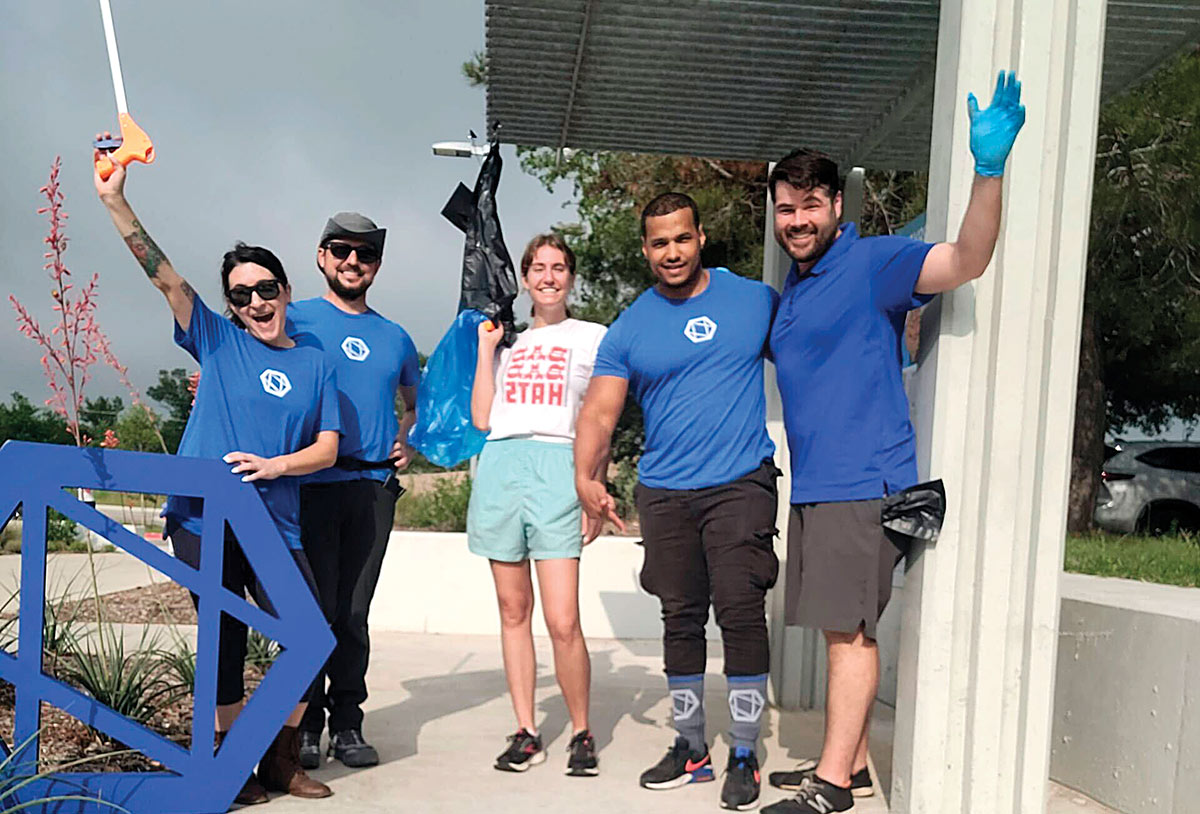
“In our industry, many products often lack seamless communication and require manual intervention from operators just to manage their business. Storable, on the other hand, has successfully created a cohesive operational experience that bridges the gaps, enabling operators to focus more on growth and efficiency [and] setting the benchmark for what a comprehensive storage solution should be,” said Snyder. “It’s truly rewarding to be a part of an organization that thinks big in every aspect. Our philanthropic endeavors are pretty big in both scale and impact, and so is the suite of technology and the solutions we have to offer. This is how we distinguish ourselves from our competitors and why we’re able to create big change in our communities.”
Charity Storage utilizes existing storage facility operations to raise funds to support charities throughout the United States. Donated and abandoned items are placed into a vacant unit and the contents are auctioned off on site or online via StorageTreasures.com or other online auction platforms. Operators online with StorageTreasures.com can opt-in via their account dashboard today and start selling charity units immediately.

magine a day where kindness knows no bounds, and the ripple effect of individual compassion leads to year-round funding for charitable causes worldwide. That’s the magic of Giving Tuesday, which empowers individuals and communities to make a tangible difference in the world by rallying around nonprofits that need support.
Giving Tuesday is a global movement, occurring annually on the first Tuesday following Thanksgiving. It serves as a counterbalance to the consumerism of Black Friday and Cyber Monday, redirecting the focus to acts of kindness and charitable giving.
While Giving Tuesday is only a single day, it’s also the official kickoff to the year-end giving season. It raises awareness and funding for causes that span all categories, potentially inspiring people to spend less on holiday shopping and instead contribute a portion of those resources to nonprofit organizations they stand behind. This year, in 2023, Giving Tuesday will fall on Tues., Nov. 28.

They wanted to establish a giving day that reminded everyone of the true meaning of the holiday season, encouraging people to think beyond materialistic pursuits and contribute to meaningful causes that positively impact society.
Here’s why Giving Tuesday matters today:
- Fostering generosity – Giving Tuesday dedicates a day to radical generosity, encouraging individuals to cultivate a culture of philanthropy and altruism. It reminds people of the joy and fulfillment of helping others and contributing to charitable causes that resonate with their values.
- Creating positive change – Giving Tuesday provides a unique opportunity for individuals and organizations to support various causes, from education and healthcare to environmental conservation and social justice. It can drive substantial resources toward addressing pressing global challenges as a collective force.
- Promoting global impact – Giving Tuesday has become a global day, celebrated in numerous countries worldwide since its birth. It transcends cultural and geographical boundaries, promoting global unity and compassion.
- Empowering nonprofits – Giving Tuesday is a crucial fundraising event for nonprofits and charitable organizations. It allows them to gain visibility, attract new donors, and engage with supporters interested in making a greater social impact.
- Building community – Giving Tuesday unites people, businesses, and communities around a shared purpose. It cultivates a sense of togetherness, reminding us that we can make positive changes when we work together.

Not sure where to start? Here are some diverse and impactful options that StorageGives supports year-round:
- Shriners Childrens – Shriners provides specialized pediatric care for children with over 1.4 million patients treated. Their treatment ranges include burn care, cleft palate, and spinal cord injuries.
- Kure It Cancer Research – Kure It continues its quest to raise awareness and fight cancer. By utilizing impactful events and groundbreaking initiatives, Kure It grows its community partnerships, fosters donor relations, and provides funds for vital research grants. Funds from Kure It begin the cancer research cycle that can lead to new discoveries, clinical trials, and breakthroughs in cancer detection, prevention, and treatments.
- Home for Our Troops – Homes For Our Troops is a publicly funded nonprofit organization that builds and donates specially adapted custom homes nationwide for severely injured post-9/11 veterans to enable them to rebuild their lives.
- Mission Feeding – Mission Feeding outreach has been a proven answer to the nutritional needs of starving and malnourished children. Each bowl of food contains vitamins and nutrients needed to stop the vicious cycle of malnutrition and death. Currently, Mission Feeding feeds over 350,000 children in villages across Sub-Saharan Africa.
- Alzheimer’s Association – The Alzheimer’s Association leads the way to end Alzheimer’s and all other dementia by accelerating global research, driving risk reduction and early detection, and maximizing quality care and support.
- Autism Speaks – Autism Speaks is dedicated to creating an inclusive world for all individuals with autism throughout their lifespan. They do this through advocacy, services, support, research and innovation, and advances in care for autistic individuals and their families.
- Breast Cancer Research Foundation – The Breast Cancer Research Foundation is dedicated to ending breast cancer by advancing the world’s most promising research. This year, BCRF is the largest private funder of breast cancer research and metastatic breast cancer research worldwide and is the highest-rated breast cancer research organization in the country.
- Water for Life – Water for LIFE began in 2000 and has helped provide more than 6,500 water wells so far in Sub-Saharan Africa. They have a goal of 350 new wells this year to combat the 844 million people lacking access to safe drinking water.
- Joy International – JOY INTERNATIONAL is dedicated to the prevention of child trafficking and to the freedom, healing, and empowerment of trafficked children, teens, and young adults worldwide.
Donations in 2022 increased 900 percent, through both small and large contributions from the over 600 self-storage vendors and brands that have partnered with StorageGives. Collectively, the self-storage community was able to double the number of children fed through Mission Feeding, an organization that provides meals for malnourished children in villages across Sub-Saharan Africa. Every 50 cents feeds four children, proving that each small donation has a big impact. The number of meals provided through StorageGives contributions doubled in 2022, equaling over 500,000 meals served.
Not only did StorageGives distribute over $150,000 in grants in 2022, but it grew its footprint by joining four state self-storage associations, including the Arizona, Tennessee, Louisiana, and North Carolina associations. Partnering with these and other associations allows StorageGives to expand its network of self-storage partners.
Partnering with StorageGives is simple. Operators who utilize StorageAuctions.com as their online auction vendor can choose to donate a portion of their auction proceeds to StorageGives. Vendors and other industry partners can also make a direct donation to the organization. For more information about joining the hundreds of industry partners who are making a change, visit StorageGives.org.

ecent industry articles have detailed the increasing effect of heat and natural disasters on self-storage operators and their facilities, including the November issue of SSA Magazine. If you have not done so recently, check with an insurance agent who specializes in self-storage to ensure that you have the coverage you need to protect your investment from these threats.
But what about coverage for tenants’ stored property at your facility? If your tenant suffers loss of or damage to their stored property, chances are they will look to your facility to make them whole. However, most insurance policies covering storage facilities do not cover loss of or damage to tenants’ stored property.
Moreover, many rental agreements expressly state that the operator disclaims all liability for loss or damage to tenants’ stored property, does not carry insurance for such loss or damage, and requires the tenant to have appropriate insurance coverage or other protection in place during the rental period. These provisions in the rental agreement significantly limit legal exposure for storage operators but do not solve the practical problem of an angry tenant who just found out that their property was destroyed following a flood or fire.
Of course, you could choose to pay the tenant out of your own pocket as a gesture of goodwill. Another option that operators are increasingly using is to offer self-storage tenant insurance or protection plans to their tenants. These products provide low-cost coverage for tenants’ property. Instead of looking to the storage operator to pay for loss or damage, the tenant can file a claim with the insurance company or protection plan provider (depending on how the program is structured).
How can a storage facility make these coverage options available to their tenants? The sale of insurance requires an insurance license. Typically, an individual can obtain an insurance license only after numerous hours of studying and passing a licensing examination. Fortunately for storage operators, due to the lobbying efforts of the SSA and affiliated state associations, 39 states currently allow self-storage operators to obtain a limited insurance license for the sale of tenant insurance. The tenant insurance provider will assist you with this licensing process. Three other states (Michigan, Minnesota, and Rhode Island) provide an express exemption from licensing for self-storage operators under certain circumstances.
Generally speaking, protection plans are add-ons to an operator’s existing rental agreement and do not require licensing. Operators should consult with their legal counsel and protection plan provider to ensure that the protection plan meets the legal requirements in their state.
Finally, operators should review the different products and benefits before deciding whether to offer tenant insurance or a protection plan. Either way, operators should make one of the products available to shield against financial loss from a disaster.
Please email me at jdoherty@selfstorage.org if you have any questions about your options.

e’ve all heard the hype about how the latest and greatest revenue management (RM) system can accelerate self-
storage revenue growth. Industry analysts extol the virtues of “advanced technology” as publicly traded REITs emphasize the ways they can improve the bottom line by using their advanced RM systems. But what are these systems, and are they good for the long-term health of our industry?
Essentially, RM systems attempt to predict how customers will respond to price changes on an item being sold. In many industries, there is meaningful “elasticity of demand,” meaning that as prices decrease, demand will increase. But there is very little elasticity of demand in self-storage because we sell a “needs-based” product. The item we “sell” is a month of use in a storage unit. The RM system tries to predict how an existing or prospective customer will respond to an increase or decrease in the price of a rental unit.
There are two problems with using RM systems in self-storage. The first is that algorithms always use historical data to predict customer response. That works fine when history continues to repeat itself, which has been true over the past 15 years while demand has continuously grown. Today, that historical trend has stopped because one entire segment of historical demand has disappeared. Almost no one today is selling their existing home with a 3 to 4 percent mortgage to move into a nicer home with a 7 to 8 percent mortgage! That segment of demand has disappeared, making the basis for many of today’s RM algorithms invalid.
The second problem with using RM systems in our industry is that we have almost no upside elasticity of demand, so we aren’t creating any more demand by reducing our prices. All we are doing is fighting over the limited number of customers already out there. Today, the RM-driven price reductions just create competitive responses that drive increased rivalry and a “race to the bottom” on prices. And RM systems are terrible at predicting competitive responses with no historically comparable data.
Historically, self-storage has been a very strong industry for long-term profitability because the intensity of rivalry has been relatively low. Property owners only competed within their 3- to 5-mile trade radius for very fragmented, low-ticket customers paying month to month—unlike office, warehouse, and retail properties with big-ticket customers on long-term leases. It made no sense to jeopardize profitability by cutting prices to get one small customer. But automated RM systems that don’t have the historical data or intelligence to accurately predict competitive responses are now driving advertised prices in the majority of our markets. In today’s world of reduced demand, these RM systems are seriously detrimental for the industry.


